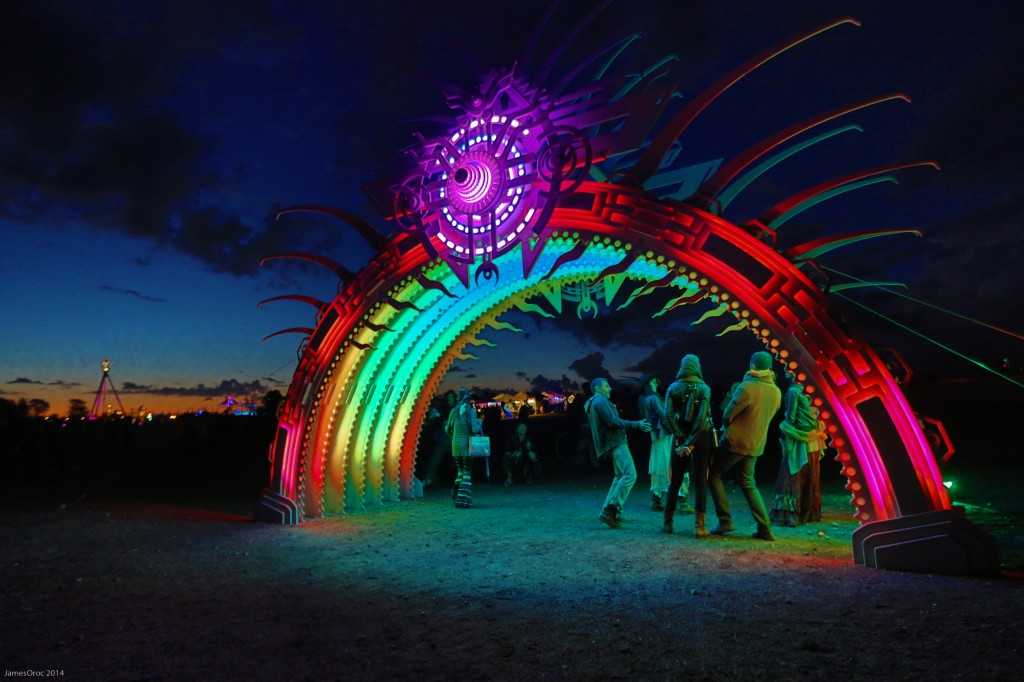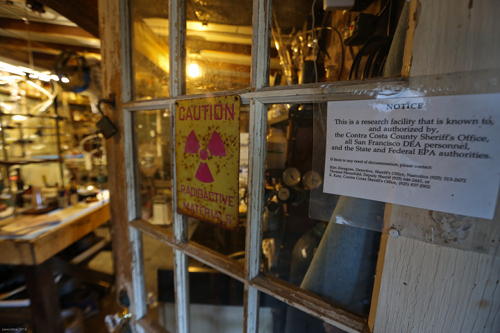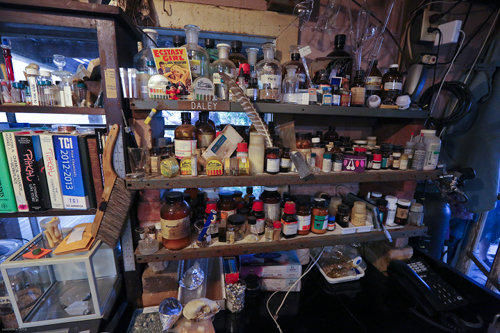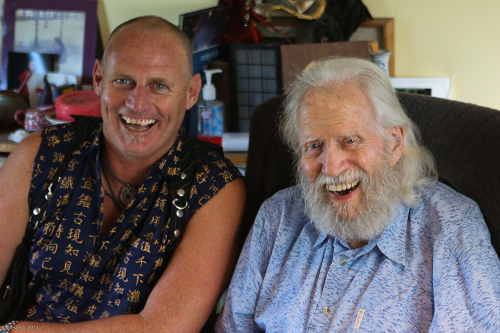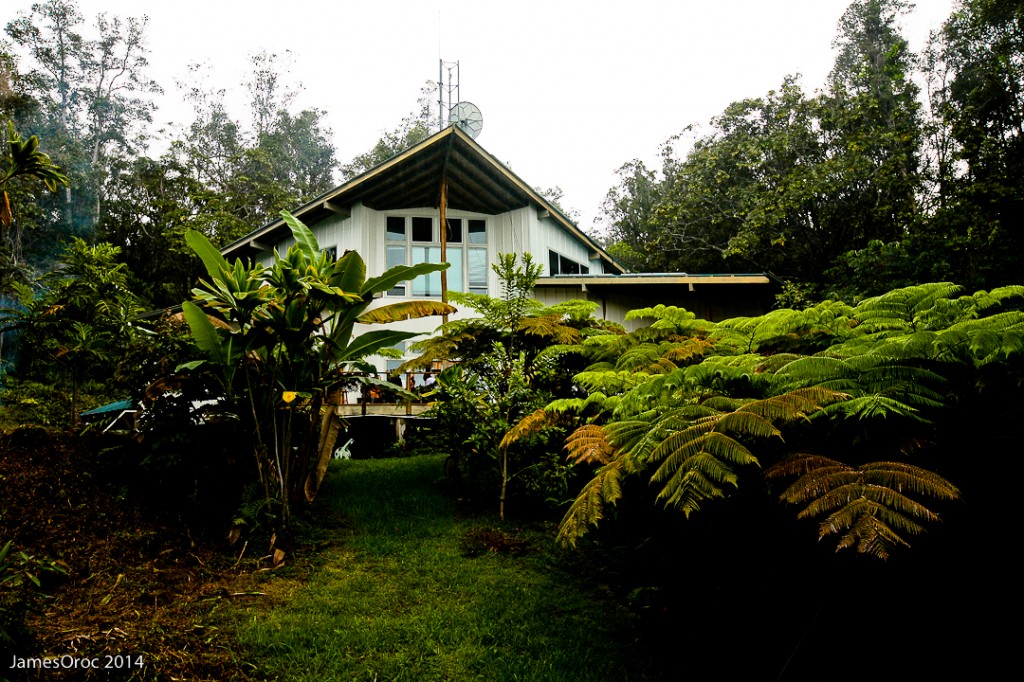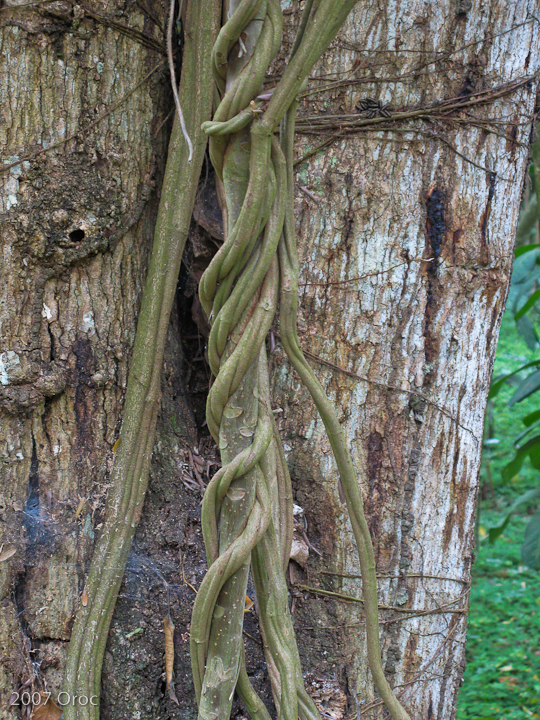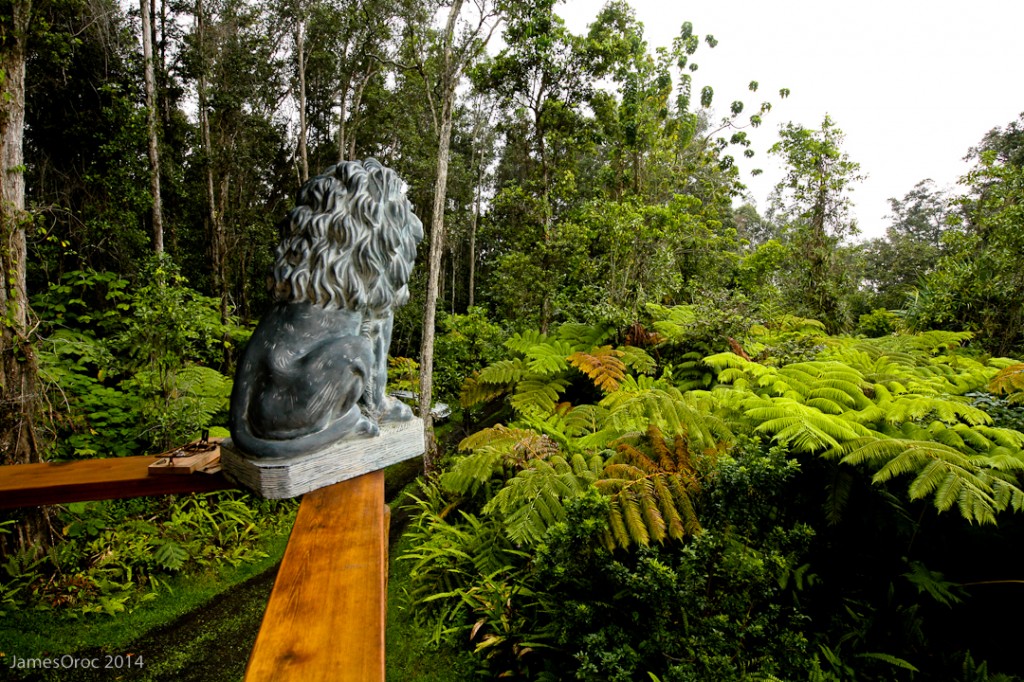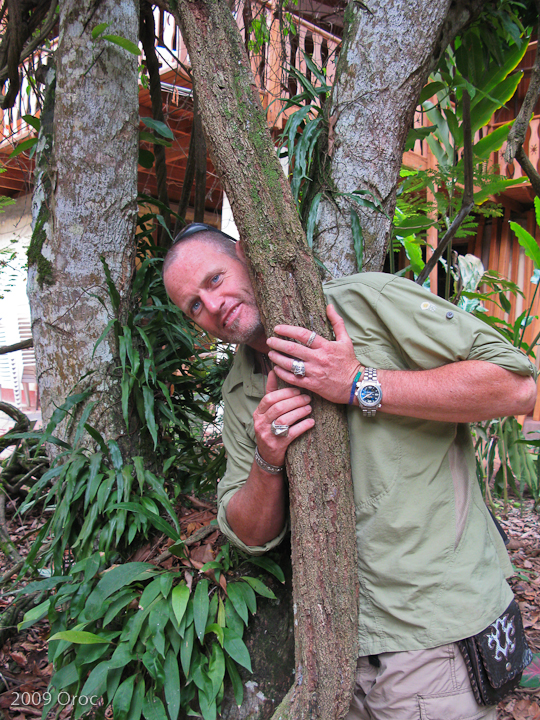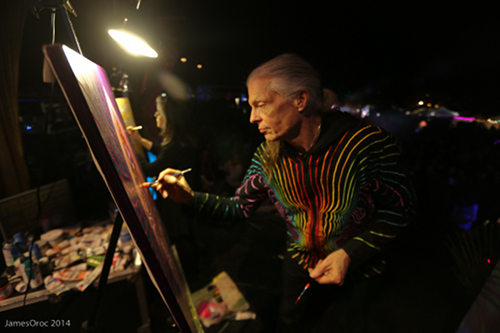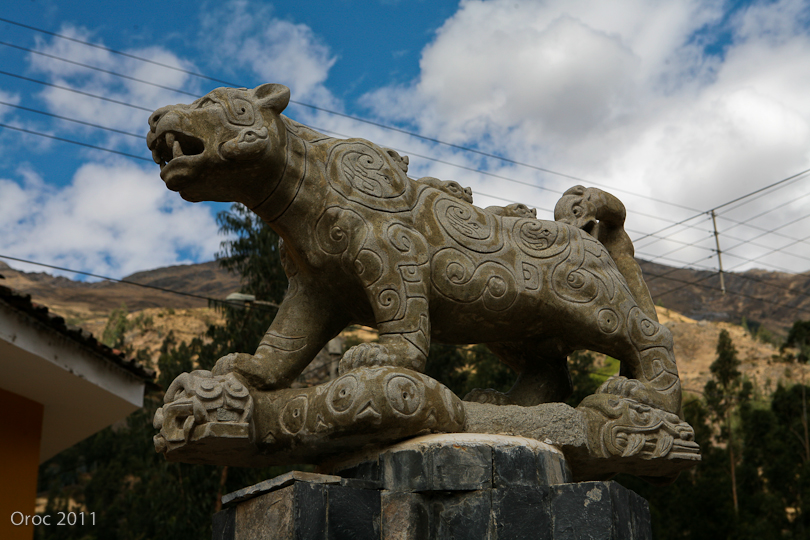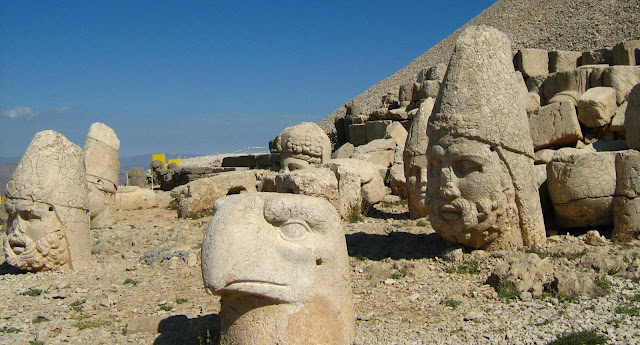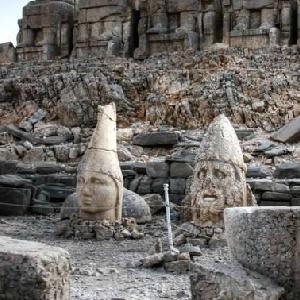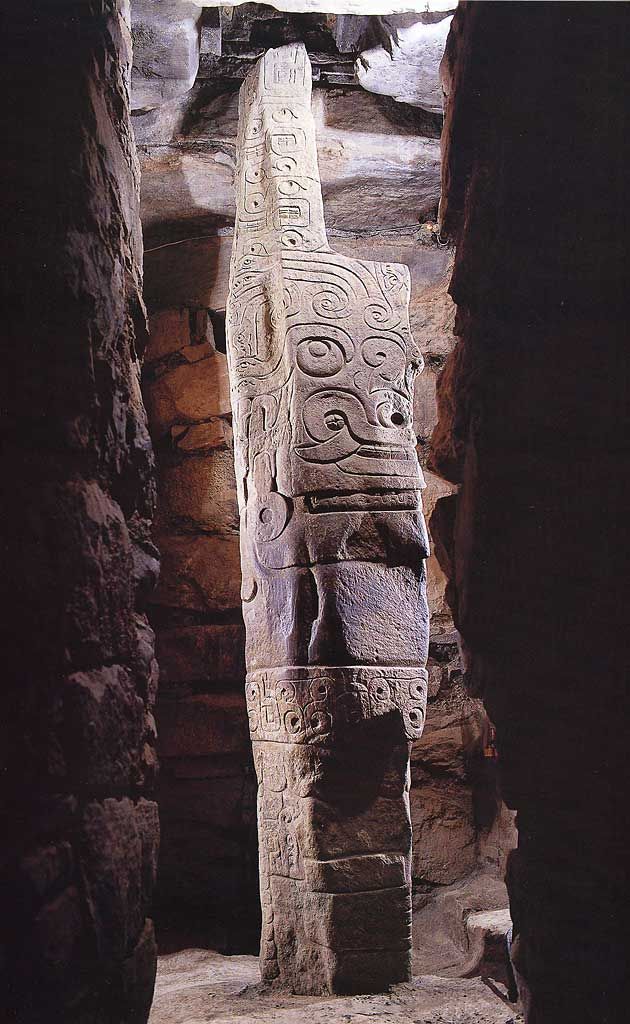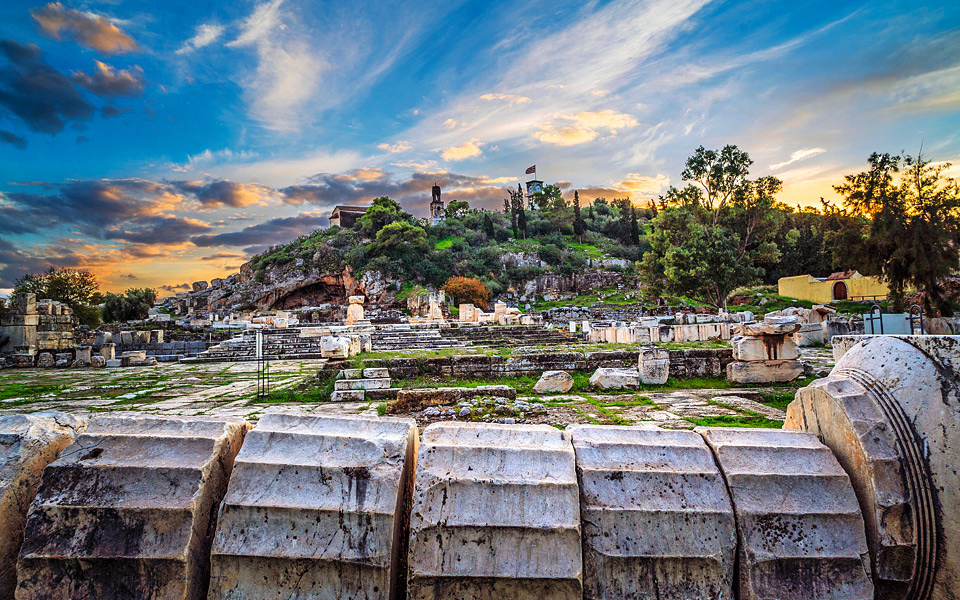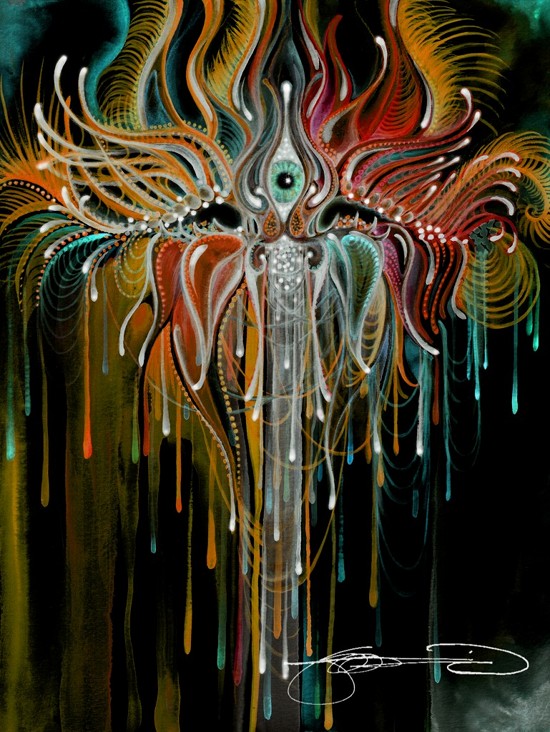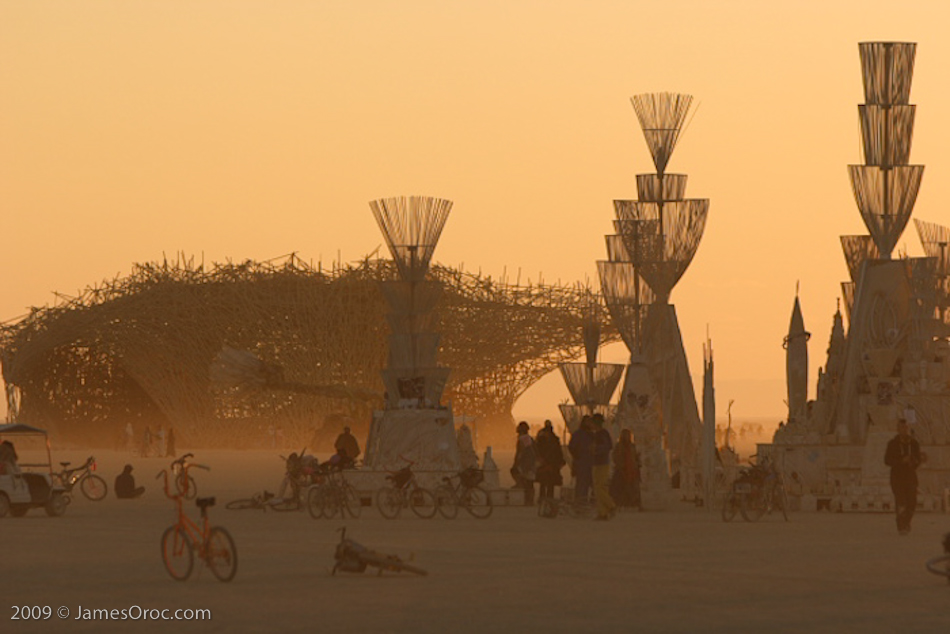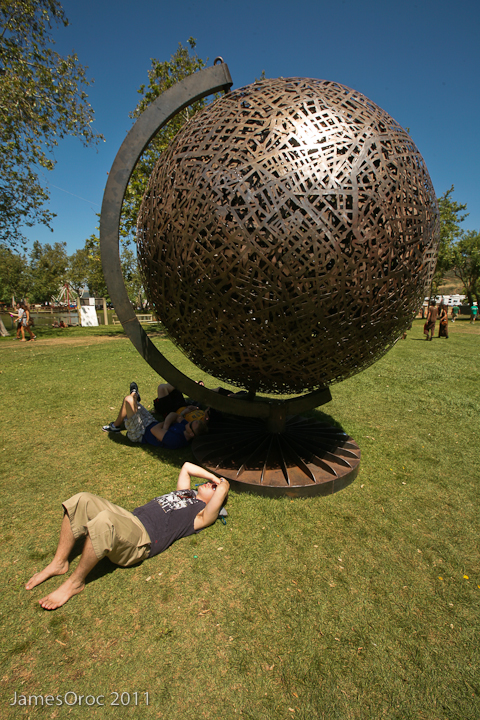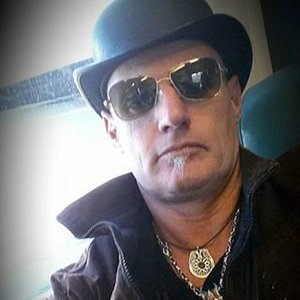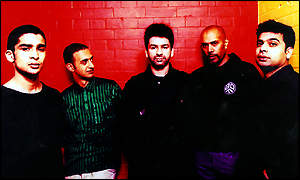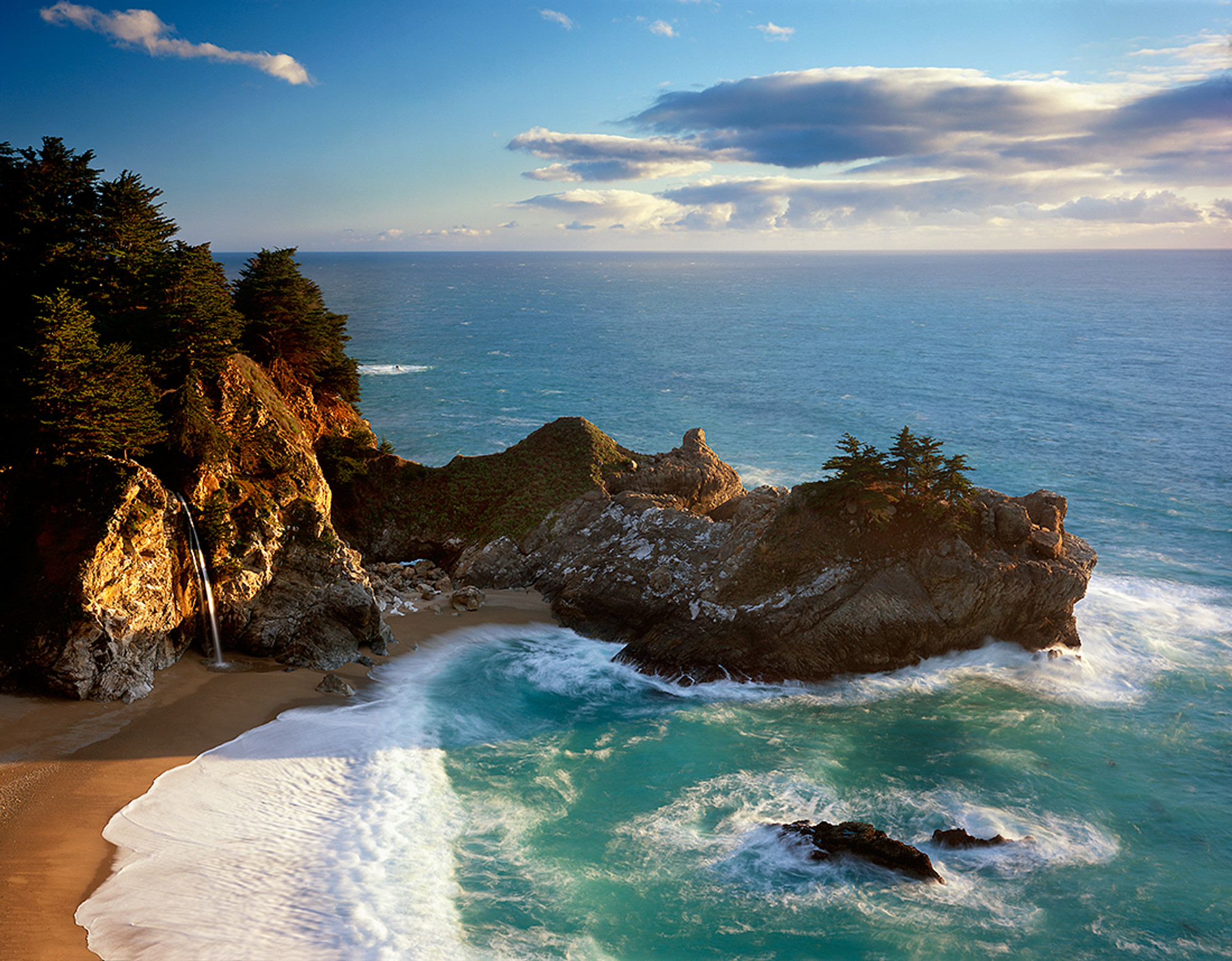Alex Grey, The Mystic-Artist
While influenced by the First Psychedelic Revolution, the current interest in readily available research chemicals, organic tryptamines, neo-tribal techno-shamanism, and Visionary Art, the defining parameters of this Second Psychedelic Revolution, have come not from the influence of Sixties psychedelic culture, but have evolved largely out of the publication in the early 1990s of the collective works of the three seminal architects of this new psychedelic era, the chemist Alexander Shulgin (PIHKAL and TIHKAL), the author and mycologist Terence McKenna (The Archaic Revival and Food of the Gods) and the Visionary artist Alex Grey (Sacred Mirrors: The Visionary Art of Alex Grey).
The influence of these 3 authors, along with the unprecedented world-wide rise in popularity of electronic music since the birth and exportation of Goa-Trance during the same early 90s era, has resulted in an entirely new psychedelic culture best represented today by the blossoming Transformational Festival movement inspired by gatherings such as Burning Man (which moved to Black Rock Desert, NV, in 1992) and the BOOM! Festival in Portugal (first held 1996). Ironically, this latest psychedelic revolution was initially much hastened by the now infamous Kansas Missile Silo bust of 2000 that saw a (luckily temporary) halt to the world?s LSD production; proving once again that Prohibition only leads to diversification.
My art has always been in response to visions. Rather than confine myself to representations of the outer worlds, I include portrayals of multi-dimensional imaginal realms that pull us towards consciousness evolution. ~Alex Grey.
From what I can glean from Terence McKennas writing, he was never a great fan of LSD; he certainly never gave it much thought after he discovered the organic tryptamines (and especially magic mushrooms). Ken Kesey, who I have always considered the best authority on LSD and the 60s psychedelic culture that he undeniably helped create, very rarely ever mentions DMT in his writings, and according to his son Zane, was not much of a fan of it. On his deathbed, Timothy Leary was asking for cocaine and all anybody had was some DMT, which, Leary being Leary, he promptly smoked. When he came back from what was his last psychedelic experience, Leary said in some confusion that he had just met up with William S. Burroughs in heaven. Burroughs meanwhile, despite the fact that his prose has become synonymous with opiates, was the original psychonaut-author, having written a book about his travels to Colombia and Peru in the 1953 in search of yage (ayahuasca) in an effort to break his opiate addiction, (The Yage Letters), as well as being one of the first people to shoot straight DMT recreationally in London in the early 60s. (An experience that terrified Burroughs so much that he wrote a letter to Timothy Leary warning him about the dangers of the drug). By the time LSD came along and kick started the First Psychedelic Revolution (with the enthusiastic help of Burroughs?s close friend Allen Ginsberg), Burroughs had apparently already seen enough, and he was a notable non-participant choosing to witness it all from the sidelines with an amused and knowing eye, his biographers now mostly erroneously reporting that Burroughs didnt like psychedelics.
One mans medicine can be anothers poison, one mans heaven another mans hell. An individuals biochemistry can be a very tricky thing, and if there is one thing that history has established it is that there is no universal cure. The common ground in psychedelics lies in the actual experience itself, the mystical transpersonal experience being remarkably similar irrespective of the vehicle that takes you there, while the psychoactive compounds involved are merely different fingers that point at the same moon.
The four authors cited above, McKenna, Kesey, Leary, and Burroughs, all deserve special mention because they have been most responsible for translating the psychedelic experience to the outside world, a custodianship held by writers since the Beat Generation. (Musician/writers such as Bob Dylan, Jimi Hendrix, Neil Young, John Lennon, the Grateful Dead, and Jefferson Airplane etc, who were the inheritors of the Beat Poet tradition, should also be included in this category.)
In a 1998 interview with Alex Grey published in The Entheogenic Review, the interviewer (Jon Hanna) points out that describing the Psychedelic Experience had until that point mostly been the territory of writers, since other than the poster and blotter art of the psychedelic 60s, few visual artists have openly admitted the influence of psychedelics upon their work. With the publication of Sacred Mirrors: The Visionary Art of Alex Grey in 1990, the psychedelic community soon discovered that the art contained within its pages resonated to many like miraculous snap shots of the psychedelic realm, faithfully rendered vistas brought back with great skill from the far shores of the visionary experience. And when Alex and his wife and fellow-artist Allyson Grey first addressed the Psychedelic Community at the Mind States conference in Berkeley, CA, in 1997, they discovered for the first time an enthusiastic audience to whom they didnt have to apologize for their own psychedelic use.

Since this fateful nexus, Alex and Allyson Greys influence on psychedelic culture has been unparalleled. The use of Alex Greys artwork on the album covers and stage shows of bands like Tool and The Beastie Boys greatly increased his general popularity with youth culture, while the inclusion of his artwork in the actual Burning Man structure in 2006 essentially anointed his chosen status as this generations most important psychedelic artist.
Over the last two decades, the Greys have inspired and actively encouraged a whole new generation of classically trained and highly talented Visionary Artists (most notably Luke Brown, Carey Thompson, Android Jones, Amanda Sage, Michael Divine, and Shrine) who have taken up the torch and become the new shock troops of the psychedelic experience. Working together in collectives, these younger artists work with stage, lighting, and sound engineers to create psychedelic environments of considerable sophistication at (often remote) transformational festivals and other events around the globe, generally with a Visionary Art Gallery attached displaying their own work (most notably BOOM! in Portugal and FractalNation at Burning Man); while the internet has provided the ideal vehicle to spread this inspired collective vision around the globe as posters, stickers, clothing, and the imagery for thousands of websites.

While still painting (often live on stage at major events and festivals), Alex and Allyson Grey themselves have embarked on what is probably the most ambitious psychedelic art project ever, the long-term construction of a Chapel to house the Sacred Mirrors series, and as a genuine pilgrimage site for visionary art.
“
The underlying primary psychic reality is so inconceivably complex that it can be grasped only at the farthest reach of intuition, and then but very dimly. That is why it needs symbols.’ ~Carl Jung.
In the earliest body of work that has established Alex Greys special place in psychedelic history, his art manages to blend the physical realms of the human body, a feat in itself only achieved by many years of training in medical drawings, with the psychic energy fields and auras of the mystics and quantum physicists, the knowledge of which has come to the artist from years of meditation, study, and contemplation. Human figures are stripped of their covering (the skin encapsulated Ego to reveal a complex multi-colored system of organs, bones, veins, and arteries that can be seen to be generating rainbow fields and crackles of pure white energy that penetrate the vacuum in every direction, an effect that could seem ghoulish were it not for the presence of the subjects eyes, which gaze out at the viewer with an often astonishing humanity and are revealed as the true
windows of the soul.
Published in 1990, Sacred Mirrors; The Visionary Art of Alex Grey has now sold over 150,000 copies and has been translated into ten languages. The Sacred Mirrors series itself is twenty-one paintings that are conceived to be viewed as a single experience; and a kind of psychic map to reconnect us with the spiritual by stripping away the various layers, the biological, sociopolitical, subtle, and spiritual aspects of the self, to reveal the universal essence.
Later Alex Grey paintings show these figures complete with skeletons, veins, and aura fields, in the acts of prayer, dancing, loving, dying, all powerful visual metaphors that seek to integrate the connection between body-mind-spirit, and the great mythologist Joseph Campbells assertion that the human body is a bio-organic field-generator, a series of energy fields that are generated by the bodys major organs, the chakra system in the Vedanta, and that combine into one singular field of consciousness that is the ego of the human individual.
Both mythology and great art often originate at the juncture of numerous competing and coalescing streams of human thought, and both Joseph Campbells ideas and Alex Greys art have arrived at a time where modern scientific thought is undergoing a radical paradigm shift as we move away from the old Newtonian ideas about singular points in time and space (a human construct) to the realization that the Universe is as series of interpenetrating fields being generated out of the Quantum Vacuum, and that all forces, (including most likely consciousness) that originate, and potentially operate, at this unseen quantum level.
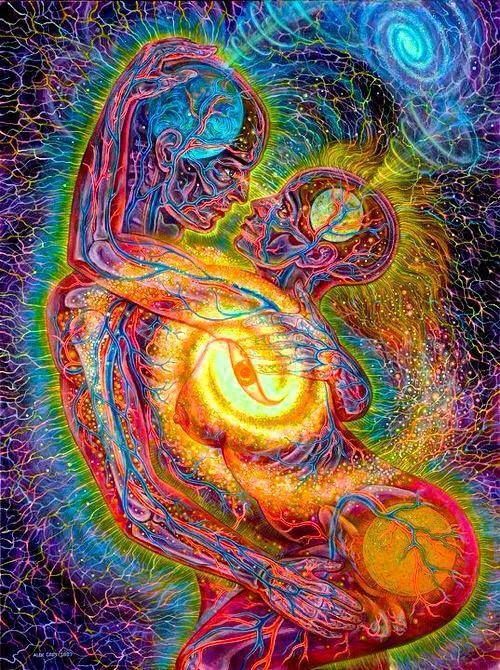
Alex Greys art is a powerful visual metaphor for a concept that is often difficult to grasp, so skillfully combining the scientific vision that our generation has become accustomed to with the ancient knowledge of akashic energies and aura fields that the two become effectively integrated, and a kind of transmission of teaching or enlightenment occurs, often without the viewer having any knowledge of the complex entanglement of meditations and philosophies that have resulted in the artists singular view.
Technically, Alex Greys paintings reveal great skill and years of training, while viewed from a strictly philosophical platform, they represent the hard-earned understanding of a significant philosophy, a viewpoint so clearly grasped that the artist is capable of transmitting that knowledge to others through the remarkable clarity of his vision. (Alex Grey himself often describes his art as a visual philosophy.) A stunning achievement, and one made all the more significant in these days of brutal prohibition by Alex (and Allyson) Greys enthusiastic championing of psychedelics (or entheogens as they prefer), and their frank admission that many of these visions have been delivered to them via the psychedelic experience.
The most obvious example of how influential the publication of the art-book Sacred Mirrors; The Visionary Art of Alex Grey by Inner Traditions has been to contemporary psychedelic culture is the fact that the entire contemporary genre of what would have once been called psychedelic art is now called Visionary Art by the growing number of artists, curators, galleries and collectors who participate in it. The term Visionary Art, as mentioned by Ken Wilber in his introduction to Sacred Mirrors, Alex Grey has taken from the mystic-artist William Blake, and was encouraged by his editor Ehud Sperling to include it in the title.
What exactly is meant by Visionary Art is hard to define and can mean a number of different things to different people, but it generally implies a respect for the Sacred or at least a glimpse into the Mystical, and the belief that the art has arrived as a transmission from the Absolute or God, rather than purely as an invention of the artist. (Much in the same way many now prefer to use the term entheogens, rather than the more tainted term, psychedelics.) While not recognized or accepted by the traditional art world (Alex Grey, for example, has had few museum shows, and is not represented by any major gallery), the still nascent Visionary Art Movement is undoubtedly the most vibrant and youth-driven form of art available in the world today, and it is quite happy to showcase itself at the events and festivals it creates, most notably Burning Man, which is arguably the most significant development in the art world, and should be recognized as the last 20th century / first 21st century art movement. (
Burning Man art and
Visionary Art are pretty much 2 sides of the same coin, with the incredibly profound and gorgeous Burning Man temples of David Best, Shrine, and others being the ultimate example of where the two meet.)
Alex Grey has said that after the unexpected death of Terence McKenna, he felt that he (and others) had felt the call to
step up and speak out about psychedelics to try and occupy the void in psychedelic culture that Terences early departure created. And one of the reasons that Alex Grey has become the most popular speaker on psychedelics since Terence McKenna, and perhaps the thing that separates him from other visionary artists?is the fact that there is a serious philosophy behind Alexs work, and that he himself has been (and continues to be) one of the great students of psychedelic history.
The fact that Alex Grey was more than just a great painter became obvious in 1998 with the publication of his book The Mission of Art that revealed the extent of his underlying philosophies. (I personally consider Alex to be a philosopher who uses painting as the main medium for explaining his philosophy.) Tracing the development of human consciousness though art, and the role of the artist as a kind of lightning rod for the future, the corner stone in Alex Greys philosophy comes from the assertion by the universal historian Arnold Toynbee (1889-1975) that the growth and decline of civilizations is a spiritual process, and that new civilizations arise to give birth to
better religions.
Proposing that the creation process of the artist is a mystical link with the source of the creation process of the Universe itself, and that Visionary Art itself can be the foundation for a new world religion, Alex Grey is the first major psychedelic voice since Aldous Huxley and Alan Watts to return the conversation about psychedelics back onto traditional mystical grounds. A long time Vajrayana practitioner, Alex Greys personal psychedelic philosophy diverges sharply from Timothy Learys often politically-inspired rhetoric, or Terence McKennas fantastical talk of self-replicating tryptamine elves and the mushroom spore as a spaceship, by rationally arguing that psychedelics are in fact the most effective way for modern man to truly know God.
In his incredibly popular slide-show presentation that he and Allyson Grey offer to promote the construction of the Chapel of Sacred Mirrors, Alex Grey traces psychedelic history all the way back to the cave painters and explains to his enthusiastic audiences that both psychedelics and art have been an integral part of the religious experience for thousands of years. The only speaker in the psychedelic community these days that has the power to hush a packed dance floor and make the kids willingly sit down, Alex Greys
pull has in fact become so great that when he and Allyson appear at festivals to live paint and give their talk/slide show, they are now often in fact the headlining attraction. For while Alex Greys work is pretty much entirely outside of the mainstream art world, these days he may well be the most popular artist in America.
The test for that popularity will be the construction of the actual Chapel of Sacred Mirrors on land purchased by the Chapel of Sacred Mirrors Foundation in Wappinger Falls, New York, in 2008. An ambitious project that will take many years to complete, the Greys appear undaunted in their task, and CoSM was granted Church Status that same year. Since the unfortunate death of Terence McKenna in 2000, and the stroke suffered by Sasha Shulgin in 2010, Alex and Allyson Greys tireless advocating of both the importance of psychedelics to our society, and of having hope for our future, has made them both the psychedelic communitys most popular speakers, and its most important voice.
-----
A Short Psychedelic History of Humanity
Over the course of the past four parts of this article, I have proposed that a new
Second Psychedelic Revolution has arisen phoenix-like at the end of the 20th century out of the ashes of the original 1960s LSD-and rock n roll revolution; and that the foundations of this new,
Second revolution (new psychedelic analogues, organic tryptamines, techno-shamanic tribalism, and
Visionary art) have mostly emerged from the published work of its three principal architects/authors, the chemist Alexander Shulgin, the mycologist and philosopher Terence McKenna, and the mystic-artist Alex Grey.
This is, of course, something of a generalization, designed to elucidate the point that there is a new psychedelic
ground-wave moving through our contemporary society. There are of course other factors and other people who have contributed greatly to this ongoing process and who also deserve mention; most importantly Rick Doblin and MAPS who have almost single-handedly led the fight to get psychedelic research back into the Universities; Dr Rick Strassman, for conducting the first DEA approved psychedelic trials in the USA in over thirty years, and most recently, for creating the Cottonwood Institute; Roland Griffith, for his repeating of the
Marsh Chapel Experiment at Harvard, perhaps the most important event in psychedelic academia since Timothy Learys original tenure; and Stanislav Grof, for his sustained examination of the transpersonal realms and its relationship to the human psyche. There is also a new entheogenic generation emerging, with visual artists such as Android Jones and Amanda Sage creating their own followings, authors like myself and Daniel Pinchbeck who have managed to have books on psychedelic culture widely published despite a virtual ban on the subject in general society, and popular DJs with evocative names like Mimosa and Run DMT.
Other factors greater than any individual have also been involved. The birth and rapid world wide growth in popularity of electronic music since the early days of Londons Acid House coincided with the gestation of this latest Psychedelic Generation and has provided a willing audience, with the two cultures effectively merging in many areas. The importance of the creation of the Internet on contemporary psychedelic culture also cannot be emphasized enough, since this is the first global network that has defied censorship, and has been able to widely disseminate rational information about psychedelics and psychedelic culture without fear; an entire article could easily be written on this subject alone. Earth and Fire Erowid deserve a prominent mention for their pioneering example of EROWID.org, which remains the most important psychedelic site on the World Wide Web due to its thoroughness and practicality, and is an inspiration to a host of other sites such as DMT-Nexus, and DMTsite.com; while E-zines such as Reality Sandwich have evolved into viable social platforms publishing information relevant to the emerging communities that support them; a large portion of which is information on psychedelic culture that would not be published anywhere else.
The idea of a
Second Psychedelic Revolution is an evocative one, for it hints at the possibility that the
First Revolution had not entirely failed. But the fact of the matter is that the contemporary wave of interest in psychedelics is not really
The Second Psychedelic Revolution, nor should the 1960s LSD-and-Rock N Roll revolution be considered
The First. Psychedelic revolutions in various societies
psychedelic transformations might be a better term, are now being realized by anthropologists and historians to have been somewhat common throughout mankinds history, and may prove to have been essential to the development of our planetary culture.
Humanity has two histories: the short history since written language evolved, and the vast unknown history of the oral traditions that preceded it during an era that some tribes now describe as
The Great Forgetting. How language, and later literature, evolved to separate us from all other life on this planet by giving us the ability to store and transmit one generations combined knowledge to the next remains one of the great mysteries of our existence. Time moved much slower before written language, and great traditions such as the cave painters continued uninterrupted for tens of thousands of years?a concept almost inconceivable in this modern age.
What we currently believe however, thanks in part to the hard science of the Human Genome project, is that at some point somewhere around 50,000 to 70,000 years ago, the ancestors of our modern humanity were in deep trouble. Forced by sub-Saharan desertification out of their formerly forested environment in south-west Africa (the original Lost Garden), these early humans existed as scattered small tribes, with a total population numbering in the thousands, scavenging along the land bridge between Africa and western Asia, right on the verge of extinction.
Something quite incredible then happened, some deep unknown catalyst for a new kind of evolution that had never occurred before. One small wavelet of Homo Sapiens, numbering perhaps as few as a thousand, these are the direct genetic ancestors of all the non-African races, would then migrate into Western Asia in a revolution of behavior that some archeologists believe included more sophisticated tools, wider social networks, and the first art and body ornaments. Marked by the point of this tenuous migration out of Africa and due to some still unknown fulcrum or flash-point, this is the moment that Homo Sapiens appears to have clearly made its radical break from the other hominoids, and began to exhibit
fully modern behavior in complex art and tool-making. Language and religion also probably began to rapidly evolve at this juncture as man embarked on his relatively short march to dominate the planet like no other species has ever before it.
The mycologists Gordon Wasson and Terence McKenna have both proposed that the spark which caused early Homo Sapiens to first conceive of God and language was due to the accidental consumption of the psilocybin (or magic) mushroom that would have been ubiquitous in the dung of primitive cattle. (The Horned Goddess of the Neolithic cults represents that link between cattle, mushrooms, and the first religious cults.) This theory is practically unprovable (as are most theories about our ancient history) but it is interesting to note that many of the strange t-shaped carved pillars at Gobekli Tepe in the Anatolia region of Turkey, founded in the 10th millennium BCE and currently believed to be the oldest
city in the world, certainly resemble mushrooms, and that ancient cave paintings (5,000 BC) of hominoids with mushrooms coming out of their torsos have been found on the Tassilli plateau of Northern Algeria.
What we do now know from more than a century of anthropological studies, is that the primary spiritual practice employed by primitive hunter-gather societies is a variety of forms of shamanism, the practice of using altered states of consciousness to mediate with the Spirit World. While our use of the word comes from the Siberian word aman (meaning literally
one who knows), the practice of shamanism was widespread throughout the planet, and especially in Africa, Asia, and the Americas. The vast majority of shamanic practices involved the sacramental use of psychotropic plants. (Other techniques, such as fasting, drumming, and chanting are now thought to have developed in areas that such plants were rare or unavailable.)
In the Amazon basin, one of the few areas where traditional hunter-gatherer societies still exist, these tribes continue to utilize a staggering array of psychotropic plants and plant-admixtures, including potent DMT and 5-MeO-DMT-containing snuffs (ya-kee, yopo, epena, parica) and the now legendary jungle-brew known by its phonetic approximation, ayahuasca. A burial site in northern Chile included a bag with snuffing paraphernalia and snuffs remnants containing DMT and 5-MeO-DMT dates back to the 8th century, although snuff use in the Amazon Basin is believed to be at least 2000 years old.
Gobekli Tepe
Six thousand years older than Stonehenge, Gobekli Tepe in the Southeastern Anatolia Region of Turkey is considered one of the most important discoveries (1996) in modern archeology. It is of particular interest, since it is believed to have been constructed by a hunter-gatherer society who only occupied it sparingly, and was actually more of a temple than a city, thus upending the belief that the establishment of sedentary farming communities was responsible for the first monumental edifices. The building of Gobekli Tepe predates pottery, metallurgy, the invention of writing or the wheel, and is even older than the invention of agriculture or animal husbandry during the so-called Neolithic Revolution. Its elaborate construction and carvings, an incredible feat for a nomadic peoples utilizing stone-age technologies, indicates that hunter-gatherer societies had clearly developed significant enough religious philosophies and practices at this point that the first house that humanity built was for our Gods. Or as excavator Klaus Schmidt observed,
First came the temple, then the city.
Over the following millennia, as the history of humanity moved out of the wilderness and into the towns and cities, so too apparently did our entheogen use, and at least four major sustained entheogenic cultures are now known to have existed. These included:
In Mexico, a remarkable number of entheogenic cults are known to have existed within the great Meso-American cultures that arose there. A variety of psychoactive plants were venerated as Gods and are commonly found represented in Toltec, Mayan, and later Aztec temples, including psilocybin mushrooms, ololiuqui (morning glory) seeds that contained LSD like compounds, and even possibly 5-MeO-DMT-containing toad venom; carbon-dating now indicates that the use of mescaline-containing peyote in North America goes back 5700 years.
Chavin de Huantar
In Peru, a significant culture arose around the sacramental use of the mescaline-containing Trichocereus (San Pedro) cactus, as evident by the construction of the Chavin de Huantar temple complex in 1300 BC by the remarkable Chavin civilization. Nestled in a verdant valley on the eastern slope of the Cordillera Blanca, the highest set of mountain peaks in Peru, the beautifully preserved Chavin de Huantar houses a sophisticated tunnel system (replete with water drains and air shafts for ventilation) that takes one under the main temple complex and through a labyrinth that, when successfully navigated, opens into a chamber with a fifteen foot high granite carving of a fanged deity, the chief god of Chavin. (Called the Lanzon, this floor to ceiling carving looks like something the visionary artist Luke Brown might sculpt.)
The Lanzon
San Pedro cactus grow in large clumps all around the temple complex, while the carved amphibitheatre at the entrance of the tunnels with its obvious fire-pit seems clear in its shamanic intent. The Chavin civilization apparently conquered other Andean societies without warfare; they simply brought the chiefs and priests of other Andean tribes to Chavin de Huantar, filled them up with San Pedro, and then led them into the underground labyrinth. By the time the stunned participants emerged back into the sunshine on the other side of the temple, they were apparently convinced enough of the superiority of Chavins shamans that they simply joined them, and Chavins influence became widespread across Peru. Incredibly sophisticated stone carvers, the Chavin civilization is considered the origin of the stone construction techniques that the Moche, Inca, and other Andean societies later used in their own temple building. The sacramental use of the San Pedro cactus has remained a continuous tradition in Peru for over 3000 years.

Underground tunnels in the main temple of Chavin de Huantar
In the Indus Valley, the mixing of proto- Indo-Iranian people with the Aryan invaders from the north created the Vedanta, the most important of the six philosophical schools (dashan) that are the foundation of what we now call Hinduism. These Aryan invaders brought with them the Rig-Veda (which dates back to at least 2000 B.C.), a collection of 1,028 hymns that is considered to be the oldest written book (and religious text) on the planet. One hundred and twenty of these verses are devoted to the praise of a plant/God called Soma, the ritual use of which was an integral part of early Vedic religion.
We have drunk Soma and become immortal; we have attained the light, the Gods discovered. Verses such as this indicate that Soma was clearly an entheogenic plant, although its identity and preparation was eventually lost. Various entheogens have been suggested, including the Fly Agaric mushroom (Wasson, Hofmann), psilocybin cubenis mushrooms (McKenna), and white lotus and cannabis preparations, but no definitive identification has yet been made. The importance and influence of this mysterious Soma on the creation of the Vedanta however, humanitys oldest surviving religion, and the philosophical system that Alfred North Whitehead called
the most impressive metaphysics the human mind has conceived, cannot be denied. According to the eminent religious scholar Huston Smith,
the Vedas derive, more than from any other single identifiable source, from Soma.
Ironically, the fourth great entheogenic culture, and the society that should be of the greatest interest to us in the West, is increasingly believed to have been Ancient Greece, the philosophical bedrock from which our own Scientific-Reductionist (and thus anti-entheogen) beliefs have grown.
Eleusis
Entheogens and the West
Eleusis, a small town 14 miles from Athens, was the site of an ancient temple to Demeter, the Greek Goddess of Nature and Agriculture, whose initiation rites became known as the Eleusinian Mysteries. Held annually for over 2000 years, these Mysteries were considered the pinnacle of Greek culture, with the majority of Greek writers and philosophers, including Socrates, Plato, Plutarch, Aristotle, and Sophocles, and later Roman Emperors and philosophers such as Hadrian, Marcus Aurelis, and Cicero, all included amongst its initiates. An indication of the great importance of Eleusis to Greek society is the fact that when the Romans arrived, the only
road in central Greece greater than a goat path was the road from Athens to Eleusis called
The Sacred Way, that the initiates walked each year.
Designed
to elevate man above the human sphere into the divine and to assure his redemption by making him a god and so conferring immortality upon him, the Greater Mysteries were held in late summer each year and lasted for 10 days. After purifying themselves in the sea at Phaleron, fasting, and then participating in the ritual-filled procession to Eleusis, the great mystical revelation came after the initiates drunk a special drink of barley and pennyroyal called kykeon, and then entered the great underground hall called the Telesterion, where the true nature of the Mysteries were revealed.
This much we know; but since revealing the Mysteries themselves to the uninitiated was punishable by death, we do not know a great deal more, other than that certain sacred objects were revealed by the hierophants (temple priests and priestesses), and that there was some kind of a grand ritualized performance, often said to involve fire. According to Proclus, who is often described as the last great Greek philosopher, the performance of these Mysteries
cause sympathy of the souls with the ritual in a way that is unintelligible to us, and divine, so that some of the initiates are stricken with panic being filled with divine awe; others assimilate themselves to the holy symbols, leave their own identity, become at home with the Gods and experience divine possession.
The Mysteries retold the ancient story of Demeter and her virgin daughter Persephones abduction by Hades, the lord of the Underworld. As Demeter searched ceaselessly for her missing daughter, she stopped performing her task of maintaining the Sacred Law, the seasons halted, and all life began to wither and die. Faced with the extinction of all living things, Zeus sent his messenger Hermes to the underworld to bring Persephone back; upon her departure however, Persephone breaks her fast with either 4 or 6 pomegranate seeds. By a rule of the Fates, this act binds her to Hades and the underworld for at least 4 months a year. Persephones return to her mother each year thus coincides with the arrival spring.
Western scholars have for centuries identified the Eleusinian Mysteries with Demeters role as the custodian of the seasons and as the Goddess of Agriculture. In her search for Persephone, Demeter became tired, and rested for a while at the palace of Celeus, the King of Eleusis, where she nursed his sons, Demeophon and Triptolemus. It is to Triptolemous that Demeter taught the secrets of Agriculture, giving the gift to humanity of planting and growing grain.
That gift however came at a cost; Demeters original intent had been to bestow the gift of immortality upon Demeophon, but she was interrupted by the boys mother. Agriculture thus was our consolation prize for immortality, and any real understanding of the Eleusinian Mysteries must realize that these two themes are irrevocably entwined. The Greek Mother-Goddess Demeter was Goddess of Nature as well as the Harvest, and thus responsible for the Sacred Law, the uninterrupted cycle of Life and Death. A scholar with a more entheogenic perspective will also notice an obvious mirroring of this myth of Persephones descent, and then return, from the Underworld; her journey mimics the most central shamanic requirement, the psycho-spiritual death and rebirth of the shaman on his own journey to the Spirit World.
This is the most shared characteristic of shamanism worldwide, the idea that the shaman dies and then is reborn with new knowledge. And judging by the lasting power of the Eleusinian Mysteries, one must suspect that some kind of a mystical-shamanic agent was involved. Commentaries on the Mysteries describe reactions ranging from extreme terror to blissful awe. Pindar, the greatest lyric poet of ancient Greece said of the Mysteries,
Blessed is he who, having seen these rites,
undertakes the way beneath the Earth. He knows the end of life, as well as its divinely granted beginning, while Sopatos remarked, in a commentary that would be familiar to any contemporary 5-MeO-DMT initiate today,
I came out of the mystery hall feeling like a stranger to myself.
The knowledge of the preparation of kykeon was lost when the era of the Mysteries finally ended, but numerous candidates have been suggested for as its psychoactive component, including psilocybin and amanita mushrooms, opiates, and DMT-containing phalaris grass or some kind of acacia with Syrian Rue; but the most compelling theory (forwarded by Albert Hofmann, Gordon Wasson, and Carl Ruck) argues that kykeon was made from ergot-parasitized barley grain that contain LSD like alkaloids (LSA, a precursor to LSD, and ergonovine).
The importance of Greek thought in our Western culture is considered irrefutable; the philosopher Alfred North Whitehead once noted:
The safest general characterization of the European philosophical tradition is that it consists of a series of footnotes to Plato. Clear, unbroken lines of influence lead from the two thousand years of Greek philosophy to early Islamic philosophy, the European Renaissance and the Age of Enlightenment. Greek philosophy made the critical break from understanding the world from a purely mythological perspective to a sustained examination of our environment based on reason. Presocratic philosophers strived to identify the single underlying purpose of the entire cosmos, and their legacy was the initiation of the quest to identify the underlying principles of reality; the origin of our Scientific Rationalism begins there.
Greek philosophys quest however was ultimately mystical, an attempt to reconcile physical laws with the presence of Spirit or pneuma. For the Stoics, pneuma is the active, generative principle that organizes both the individual and the cosmos. In its highest form, pneuma constitutes the human soul (psych?), which is a fragment of the pneuma that is the soul of God (Zeus). As a force that structures matter, it exists even in inanimate objects. To the Stoics, nothing in the world had an independent existence from this pneuma (logos). Sometimes described as an ether, the pneuma/logos is similar to the Hindu concept of akasha, and considering the importance of the Eleusinian Mysteries to the Greek philosophers, and the importance of Soma to the Vedic philosophers, one has to wonder if some kind of entheogen was not involved in this mystical realization of a transpersonal nature of reality. As Albert Hofmann, the inventor of LSD and investigator of the Eleusinian Mysteries, puts it:
If the hypothesis that an LSD-like consciousness-altering drug was present in the kykeon is correct, and there are good arguments in its favor, then the Eleusinian Mysteries have a relevance for our time in not only a spiritual-existential sense, but also with respect to the question of the controversial use of consciousness-altering compounds to attain mystical insights into the riddle of life.
By the time the Roman emperor Theodosius I closed the sanctuaries at Eleusis in 392 AD, the Mysteries had reputedly lost some of their power, with the sacred kykeon having been served at profane parties in Athens (one of the pieces of evidence that kykeon was most likely psychoactive). The last remnants of the Mysteries were wiped out in 396 AD, when Alaric King of the Goths invaded accompanied by Christians
in their dark garments, bringing Arian Christianity and desecrating the old sacred sites. And for the following 1500 years, the Western Christian based culture that evolved in Europe had no obvious entheogenic influences what so ever, and our spiritual life became dependent on obedience, fasting, and prayer.
An Emerging Fifth Entheogenic Culture?
This changed in 1897, when mescaline was first isolated and identified by German chemist Arthur Heffter, and then radically again in 1919, when mescaline was first synthesized (by Ernst Spaeth). One of the themes that continues to fascinate me about contemporary psychedelic culture is the fact that our chemistry, our anthropology, our interest in psychology, and our spiritual curiosity all evolved to a point at the beginning of the twentieth century when they became increasingly intertwined.
Mescaline, for example, was isolated after Western intellectuals became interested in the phenomenon of the native peyote inebriation of the peyote cults of the South-Western Indians of the United States and Northern Mexico. In 1887, Parke, Davis and Co distributed dried peyote (obtained from Mexico) to interested scientists. The first reported non-native account of peyote inebriation was published in 1897 by the American physician and novelist Weir Mitchell. Mitchell then sent peyote buttons to Havelock Ellis, whose accounts of his own experiments caused considerable scientific interest when they appeared in the British Journal of Medicine. Mescaline was subsequently isolated by Arthur Heffter in 1897; Heffters scientific curiosity was so great he discovered mescaline by systematically ingesting a number of alkaloid fractions isolated from the peyote himself until he identified which one was psychoactive (thus becoming the first modern psychonaut).
Once mescaline was successfully synthesized in a laboratory in 1919, scientific interest shifted to it instead of peyote. In 1927, Dr Kurt Beringer, a friend of Herman Hesse and Carl Jungs, published a 315 page study entitled Die Meskalinrausch (The Mescaline Inebriation). There are some reports of mescaline use in the late 1920s and early 1930s amongst artists and other curious intellectuals, but these experiments were interrupted by the outbreak of World War II in Europe. (Jean-Paul Sartre for example took mescaline in 1935.)
In the early 1950s, the British psychiatrist Humphry Osmond would begin to examine the properties of mescaline in his research on psychosis and schizophrenia. It was Osmond who administered mescaline to the British novelist Aldous Huxley in Los Angeles in 1953; Huxleys subsequent 10 mescaline experiences would be the basis for his book The Doors of Perception in 1954, arguably the most important and influential book on the freshly termed psychedelics ever written.
Meanwhile, in the great wave of chemical discovery at the beginning of the twentieth century, DMT had been synthesized in 1931 (although its psychoactive effects would not be recognized until 1956), and in 1938, a Swiss chemist employed by the pharmaceutical company Sandoz had invented lysergic acid diethylamide (LSD-25), the most powerful (by dosage) psychedelic known to man. The psycho-activity of this compound also remained unrealized all through World War II, and may have remained unknown had Albert Hofmann not had a strange premonition to re-examine the compound again in 1943. After accidentally dosing himself when a small amount of LSD landed on his skin, Hofmann repeated the experiment by willfully ingesting 250ug of LSD on April 19th, 1943, and LSDs psychoactive properties became overwhelmingly obvious.
The rest, as they say, is history, but the importance of Albert Hoffmans discovery is central to the psychedelic culture of the second half of the 20th century. While there have been numerous plant-entheogens in history, and other man-made psychedelics have since been invented, there had never been an entheogen that a competent chemist could make three millions hits of in an afternoon.
When LSD arrived on the cultural scene in full-force in the mid 1960s, it was the perfect psychedelic for the job, laboratory produced and packaged first as a liquid on sugar cubes and then on brightly printed sheets of paper, LSD epitomized the space-race-driven scientific frenzy of the late 50s and early 1960s in a way that ancient entheogens like peyote, psilocybin mushrooms, or ayahuasca would have never been able to, and its appeal was instantaneous. Its invention allowed an estimated 30 million people access to the psychedelic experience between 1960 and 1990, and has changed the cultural and spiritual landscape in the West more than any other identifiable modern influence (except perhaps television).
The synthesis, and subsequent invention, of psychedelic compounds in our laboratories is the unique contribution of Western culture to the psychedelic history of the world, and this is now approaching one century old. Modern psychedelic history, I would argue, begins at this date (1919), and that the early curiosity in mescaline by artists and intellectuals in the 1920s and 1930s; the MK-ULTRA experiments that came out of WW II; R. Gordon Wassons identification of the effects of psilocybin mushrooms in Life magazine in 1957; the interest in mescaline, LSD, and DMT by psychologists and psychiatrists in the mid 1950s and early 1960s; the cultural upheaval caused in the late 1960s by Western Youth cultures enthusiastic embrace of the psychedelic experience; the ongoing anthropological reassessment of Mankinds history that began in the 1970s, as we have increasingly had to recognize the role that traditional entheogens have played in Mankinds development; the discovery of endogenous entheogens in late 1970s; the rise in popularity of empathogens and the Acid-House culture of the late 1980s; the various analogues of the research chemical companies of the 1990?s; and this latest 21st century
transformational culture that has evolved from the combined works of Alexander Shulgin, Terence McKenna, and Alex Grey; are all in fact mileposts in the same modern societal evolution. And thus, instead of a
Second Psychedelic Revolution that has arisen from the ashes of the 1960s acid-fueled youth rebellion, we are in fact a century into the establishment of Mankinds fifth great entheogenic culture.
This statement raises the inevitable question at this critical juncture in human history: Why?
-----
A New Earth?
Psychedelic History and Psychedelic Philosophy are both enormous, virtually neglected fields of scholarship, and there are days where I feel like I could write endless volumes about various complex facets of the Psychedelic Experience; thus any attempt to summarize the importance of psychedelics to our contemporary culture within the confines of a single article is somewhat doomed to generalizations. However, after the surprising publication of my book on the entheogenic experience Tryptamine Palace in 2009, and now more than six years of addressing audiences around the world on these complicated and diverse subjects, I have come to some definitive conclusions of my own about both the practical use of entheogens, psychedelics capable of providing a sacred or mystical experience, and the ultimate purpose of their surprising reappearance in contemporary western culture.
Psychedelics and the Self
‘You are the World, and your relationship with another is Society’. ~Krishnamurti
There are 4 main beliefs about psychedelics that have become the cornerstones of my own personal entheogenic philosophy, and that I now regard as virtual facts.
The first of which, at the risk of stating the obvious, is that the most practical application of psychedelics in this day and age is as a tool for examining differentiated states of consciousness, and ultimately for investigating the basis of consciousness itself. This was the promise of psychedelics that first created such tremendous interest within the scientific community before research was effectively banned in the early 1970’s. This was also the same aspect of psychedelics that first fascinated experienced spiritual ‘seekers’ like Aldous Huxley and Alan Watts in the 1950’s, who both declared that a single session on psychedelics had taught them more than decades of meditation.
The second is that the ‘ultimate’ psychedelic experience is the relatively rare transpersonal experience–the blissful realization of the Oneness of All Things–and that this transpersonal experience is often identified (by some, not all) as a recognition of the Sacred Nature of Existence, a merging with Source. With the right set, setting, and psychedelic, an untrained individual can experience a very different ‘reality’ by merging with a state of consciousness remarkably different to the one that we normally occupy. Upon returning to our ‘normal’ state of consciousness, we generally lack the vocabulary for the experience, and often all we can do is meditate in silent wide-eyed astonishment upon the fractal of a memory of that Mystery of Mysteries.
The third is that this transpersonal or entheogenic experience (an entheogen is any plant or compound that can initiate a mystical experience) is phenomenologically indistinguishable from the classical mystical experience of Union-with-Source, and thus should be regarded as one.
Prior to the re-emergence of the psychedelic experience in Western Culture during the 20th Century, mystical states of consciousness were considered rare in our Society, and generally accompanied severe austerities or even obvious psychosis; while the majority of mind-altering compounds available to European society offered only a consciousness-numbing inebriation (alcohol) or narcosis (opium).
For the traumatized generations emerging from the sophisticated horrors of two consecutive World Wars, the white light of the mystical experience became something of an intellectual Holy Grail, a potential escape hatch from the existentialist crisis that Western humanity had fallen into. While Aldous Huxley’s book The Doors of Perception has gained considerable notoriety in the decades that have followed its publication due to the now illegal nature of the compounds (mescaline) and experiences (psychedelic) that it promotes, people now tend to forget that at the time of its release Huxley himself was regarded as one of the world’s great intellectuals and the preeminent expert on the spiritual/mystical experience.Thus it was Huxley’s enthusiasm for psychedelics as a genuine tool for spiritual self-examination and personal growth that generated such interest for the generation that survived World War II, and for the generation born directly after it.
The most convincing part of my own transpersonal experiences, and I would argue that this is in fact the basis of all mystical experiences, is the remarkable experience of Consciousness without Identity, as it is sometimes called. That is to say that a part of me is able to merge and identify with the Consciousness of Source/Ultimate Reality, but in doing so ‘I’ have no idea that ‘I’ exist or ever existed … me, James Oroc, human, Earthling, that complex amalgamation of cells and particles that seems to contain consciousness, now revealed to be nothing more than a vague and distant memory of some unimportant shadow of drifting star-dust, while it is undeniably the underlying and unimaginably Greater Consciousness, ‘the ground of Reality’, that remains.
It was the unexpected experience of this state-of-consciousness that is sometimes called the Universal Mind, or God Consciousness, that shattered not only the bedrock of most of my scientific-rationalist beliefs, but even my rabid atheism. After this experience, for example, I could no longer believe that consciousness originates within the physical body, but is in fact a Universal Field that our brains somehow access, and I have since come to the conclusion that evolution itself is consciousness driven. Which is to say that rather than the scientific-rationalist view that consciousness is an ‘accidental’ epiphenomenon of matter, consciousness is in fact the primary driving force of Existence, and evolution is the history of matter organizing itself into more complex forms so that this Universal Consciousness can evolve into more coherent ways of knowing Itself, a philosophy, I have come to discover, expounded in various forms by mystics for centuries.
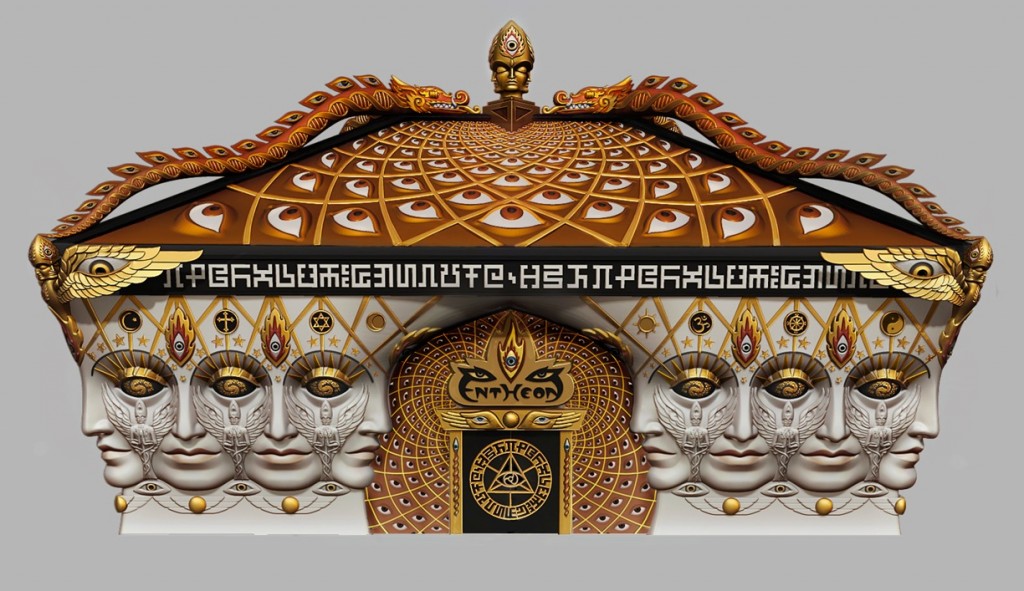
This shattering of my belief system after my unexpected and unwanted mystical experience then led to the greatest intellectual adventure of my life, the reconstruction of a world-view that could make sense of my new convictions, a journey that would ultimately be the topic and tale of my book Tryptamine Palace. One of the things I believe that makes Tryptamine Palace unique amongst contemporary psychedelic literature is that its pages not only offer some complex theories about the basis of the entheogenic experience, but actually present a model, based on neural Bose Einstein Condensates and the holographic nature of the quantum Zero Point Field – that I believe explains the mechanism of the transpersonal-entheogenic experience within the boundaries of current cutting edge science. However rather than revisiting these ideas in depth in this article, I would rather examine in greater detail some of the concepts that have evolved for me since the publication of Tryptamine Palace.
The most important of these, and one which came about directly from the recognition of consciousness without identity, was the realization that I had in fact experienced ego death, and that the Ego, something that had only ever been a little-understood philosophical concept to me previously, had now been revealed as a very real mask and entity.
There is a moment at the peak of the transpersonal experience (on 5-Methoxy-DMT) when it has all become too much, the moment when even Universal Consciousness feels like it will shatter in awe at what it is experiencing, dissolving as it is back into the mysterium tremendum, and it is at that moment that the questions appear that will bring you back. The moment a voice asks, How is this is possible? How long has this been happening? And who am ‘I’ ? With this last question, the Ego rapidly re-forms and swiftly delivers ‘you’ back to your body, which is usually collapsed in an inglorious heap upon the bed or floor. From these experiences I have come to believe that this is the most practical application of personal psychedelic use – for the recognition of the existence and role of the Ego, and for experiencing how its disruption can result in a greater connection with Source.
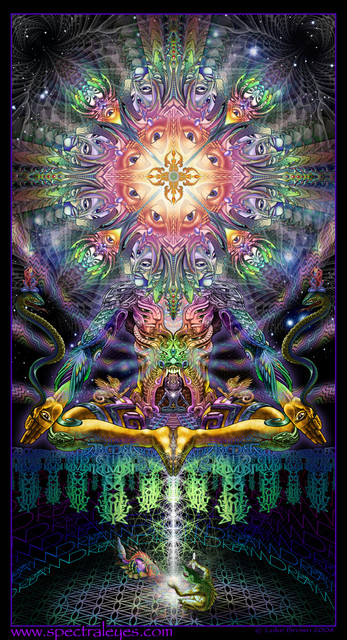
Before I venture on any further, I should define what is meant by ‘the Ego” since this particular word is fraught with numerous definitions. My own current understanding has been heavily influenced by the work of the contemporary mystic Eckhart Tolle, and especially his book A New Earth: Awakening to Life’s Purpose, (the title of which I have somewhat ironically appropriated for this article), and the basis of the definition that I am using comes largely from his work.
By the Ego I mean the mechanism in consciousness that differentiates between things and ‘labels’ experiences, by creating a thought/memory/word that becomes attached/associated with that experience. (Or quite simply, the voice in your head.) Over one’s lifetime, it is the collection of these thoughts/memories/words (that have now replaced the actual experiences themselves) that creates a sense of history and Self. Babies are born devoid of Ego, and are trained to build one – children often first talk of themselves in the third-person before they grasp the concept of ‘I’ – but once the Ego is established, it generally continues to grow and fortify itself throughout an individual’s life. Human beings are in fact the only animals that must protect their offspring for years until they can gestate to maturity – virtually all other animals must learn to survive within weeks if not days or hours – and it is the Ego that is being developed during this period of childhood and puberty. We are born fully conscious, it is our ability to put labels and values to experiences (and later abstract concepts) that we are developing towards adulthood, and along with it, our sense of ‘I’. In our modern capitalistic society, and especially in the West, one’s sense of ‘self’ is considered to be the most important thing we have, and we are taught to worship the idea of the rights of the individual above everything else; a belief now more important than family, tribe, or country. (“I have to do what’s right for me!) The grip of the Ego on the individual (and especially in the West) is now so strong that most of us never realize that there is anything but the Ego at all, and thus this is the mechanism – that Einstein called ‘an optical illusion of consciousness’ – that has separated Humanity from the rest of the web of life on this planet by causing us to believe that we are ‘unique’ and ‘special’ – made in God’s image no less – and that the Earth is here for our exploiting, rather than our custodianship.
A viewpoint of separation that become virtual dogma during the late 18th and 19th century after the scientific philosophy of Rene Descartes, whose Cartesian Duality advocated the complete separation on body and mind, paving the way for the wide-spread introduction of the Scientific Method and the absolute economic philosophies of John Locke and Adam Smith that would become the operating principles of the Industrial Revolution. (Locke famously wrote that “Unused property is a waste and an offense against nature.” According to his economic theories, which are one of the foundation stones of our modern capitalist paradigm, it is humanity’s God-given duty to subjugate the earth and reap the rewards, as “wealth’.)
Thus my fourth belief/conclusion is that a mystical experience – by any means – destroys the illusion of separation by revealing the singular ground of Reality, the Numinous, and this occurs by transcending the Ego, the overwhelming sense of “I”. (Once again, a belief commonly expounded by mystics for centuries.) This very-real experience of ego-death is the same experience that Aldous Huxley, Alan Watts, Jack Kerouac, Alan Ginsberg, Gregory Corso, and many others of the post-WWII generation were all seeking from their study of the Eastern texts and technologies; the momentary cessation of the Ego (by meditation, yoga, etc.) so as to reveal the ultimate Source of Reality. A paradigm shattering event whose Sanskrit word, satchiananda, is best translated as “being-consciousness-bliss” or “existence-awareness-bliss”, or what we in the West might describe as ‘a moment of enlightenment’.
This concept was mostly abandoned in the West since the cessation of the Eleusinian Mysteries in Ancient Greece other than in radical pockets such as the alchemist tradition, it was the Theosophists of the late 19th century who generated a wave of interest in the transpersonal teachings and methods of eastern philosophy that many western intellectuals began to investigate. (Madame Blavatsky is often credited with coining the term ‘Cosmic Consciousness’, later used by William James.) A two-year speaking tour of the United States by the remarkable Swami Vivekanada, a disciple of Ramakrishna, led to the formation of the influential Vedanta Society in the United States in 1894, and it was by this direct line to Indian mysticism that many western intellectuals were introduced to yoga, transcendental meditation, and the philosophy of the Vedanta, in a sober and often studious approach to the mystical experience – which Leibniz defined as ‘the metaphysics that recognizes a divine Reality substantial to the world of things and lives and minds’ – that steadily gained popularity with intellectuals and bohemians through two World Wars and the Great Depression, and still continues in many Vedanta and Buddhist centers today. An approach that ironically would be unwittingly undermined by the writings of the Beatniks, who while enthusiastically embracing aspects of Vedanta philosophy into their own mythology– the Dharma Bums – had realized in the periods of chaos between their lengthy meditations that there was another kind of much more accessible transcendence available with just the right mix of jazz, alcohol, benzedrine, and a then little-known illegal drug known as ‘tea’ or marijuana, in the heady liberation of smoky mixed-race music-clubs. The unlikely commercial success of Allen Ginsberg and Jack Kerouac in the late 1950’s led to a popularization of this hybrid Beatnik philosophy that would unknowingly prepare youth culture for the spectacular arrival of psychedelics shortly thereafter.
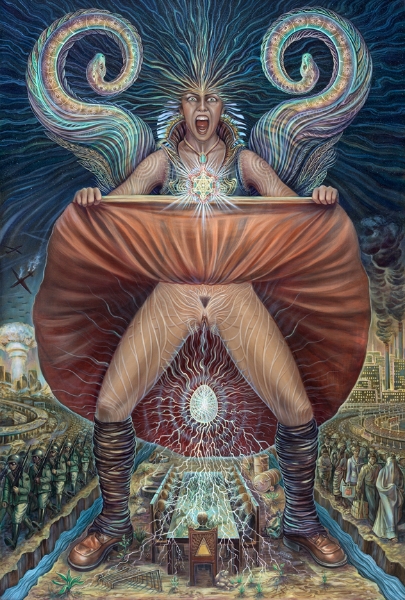
So to quickly recap, these are what I see as the most practical personal uses of psychedelics.
For examining and experiencing differentiated states of consciousness; and for examining the role of consciousness itself.
For realizing the existence of the Ego; and experiencing the field of universal consciousness without it.
For experiencing the transpersonal nature of reality that is the common ground of all mystical experiences.
For realizing our connection with Source.
Psychedelics and Society
‘The task of our generation, I have no doubt, is one of metaphysical reconstruction’ ~E. F. Schumacher
The first structure that Man built was thus in Consciousness, in the inner space that we began to call ‘our minds’; the walls of separation and division required for the construction the Ego, for the creation of the sense of ‘I’, and ultimately, of Homo Sapiens. Numerous commentators throughout history have stated that this false sense of separateness from the Universal is the inherent ‘dysfunction’ in ourselves and our Society that is stopping us from realizing our full potential. By recognizing that the human ego is the mechanism of division and separation that has been responsible for the world that we have created, then it applies that in understanding the ways in which psychedelics are useful for an individual’s personal growth, we can understand just as equally how they might apply to the collective growth, and in fact survival, of our culture. Although known to be non-toxic and non-addictive, psychedelics are currently amongst the most feared AND most revered aspects of our contemporary society (depending upon who you ask), and despite an all-out war against their use that has been ongoing for nearly 50 years, the popularity of psychedelics has in fact steadily increased (world-wide) along with the astonishing number of entheogenic compounds and plants now available, and there are signs, such as the reemergence of psychedelic research in academia and articles about ayahuasca in popular ‘women’s’ magazines like Marie Claire, that suggest that psychedelics are already returning to mainstream culture. There is a fragment of human curiosity that remains fascinated with the psychedelic experience and is willing to face any persecution to continue it’s influence, and in my opinion this is the part of Humanity that recognizes the inherent dysfunction in human thinking, and instinctively wants to break down the prisons of separateness that the modern Ego has built up around us, the part of us that longs to reconnect with Source. I also believe that this same Universal Source is equally trying to get back in touch with us, to help Humanity through this dilemma, and that entheogens (sacred psychedelics) are perhaps the only technology capable of penetrating the Western Ego’s omnipotent view of itself, and thus allowing us can learn to integrate back into the Web-of-Life again. (They are undeniably the most effective.) This is why I believe that that the reappearance of entheogens in Western (and World) culture at this critical juncture in human history is more than just a coincidence, it is in fact necessary for our future survival as a species.
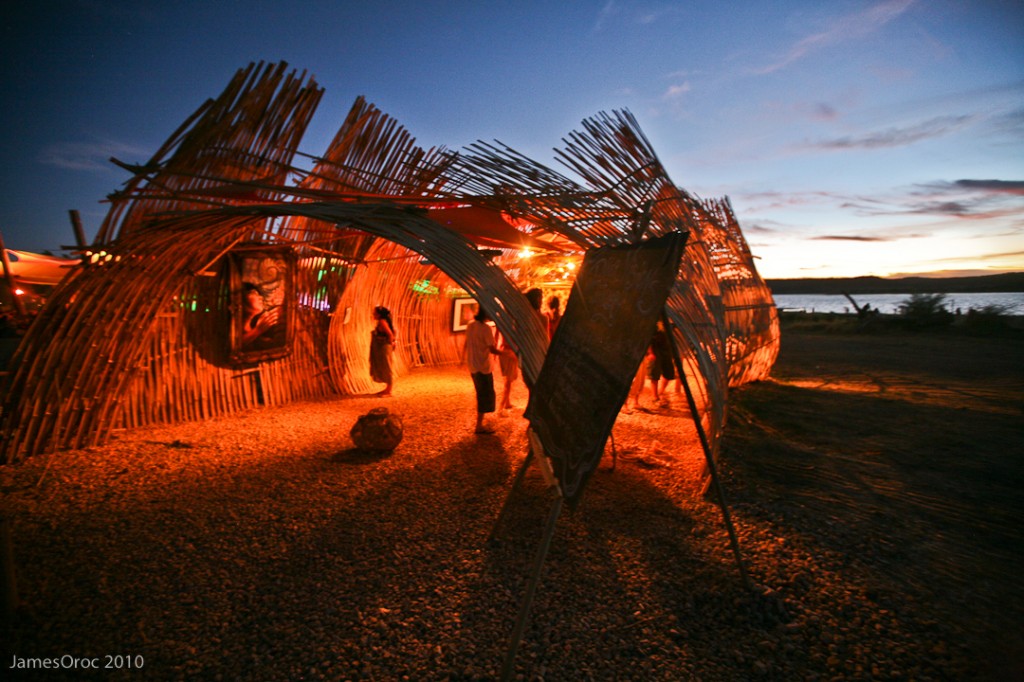
The lasting function of psychedelics must be as a tool for the reintegration of the Transpersonal Experience into the Western Mind; a very-real ‘realization’ that is brought about by the temporary disruption (and subsequent recognition of) the Ego structure, and any goal less than this should be regarded as mere entertainment. And yet while many fascinating things have been written about psychedelics and the psychedelic experience over the past fifty years, from strange tales of transformation and telepathy to ingenious theories ranging from mushroom spores as spaceship to the Soul or Spirit occupying a singular molecule, what I find most revealing is that the practical philosophy that I have acquired from my own decades of academic and personal enquiry (the belief that psychedelics are most useful for realizing and examining the role of the Ego as an obstruction to Source) is virtually identical to the excitement of Aldous Huxley and Alan Watts over fifty years ago, and yet in the five decades of psychedelic history since, this is ancient ground that has barely been revisited, as psychedelic culture has moved further and further away from self-examination, and further and further towards hedonism, escapism, and a flirtation with the fantastic.
There are a number of obvious reasons for this, one being that Huxley and Watts had the advantage of years of Vedanta study and training before they experienced psychedelics, and thus had fully-formed experiential philosophies of their own with which to compare to their psychedelic experiences. Coupled with the fact that their generation experienced psychedelics before there was any stigma attached to psychedelic use gives their writings and speeches a scholarship and an authority that few commentators since have been able to equal. (Unfortunately their philosophical comparisons of the psychedelic experience to the classical mystical experience would become discredited by association and lost in the hubris of Timothy Leary’s cultural excesses less than a decade later.) But I also believe that the core of their understanding, that the classical mystical experience can be achieved by the negation or chemical disruption of the Ego, and that this is the most useful application of psychedelics for the modern Western mind, has also until recently been considered increasingly irrelevant. In the ego-driven decades that have followed our flirtation with the transpersonal in the 1960’s, the mystical experience has been of little societal interest, and the consciousness-modifying compounds of choice have been either life-force negating drugs (heroin/ prescription opiates), potent ego-inflaters (cocaine and alcohol), or vehicles of pure escapism (MDMA), anything in fact that can help avoid serious self-examination.
This situation that has only began to change again in the past two decades, as the threat of both the impending ecological disaster and the collapse of the world’s economy – two events that are now inextricably entwined with each other – is creating an existential crisis for today’s generations not unlike the deep despair for humanity that many people felt post World War Two. In 2015, nearly 50 years after LSD was made illegal in the United States, millions of people (world-wide) will go to yoga, meditate, eat a vegetarian diet, and even occasionally take a wide variety of psychedelic drugs, all in that same search for meaning that the beatniks and the hippies once sought. This search for the mystical experience, coupled with the LSD ‘drought’ that followed the Kansas Silo bust in 2001, has resulted in a increase in interest in DMT, 5-MeO-DMT, and especially ayahuasca in the 21st century; an interest that in many way mimics the original fascination with LSD before it became illegal, the same hope for a glimmer of reason in an increasingly meaningless world.
If the function of all revolutions is to bring about change, then the 1960’s LSD Revolution remains worthy of that title, since it was a fundamental component in changing Western – and especially American – society’s views on race, sexual politics, religion and spirituality, and perhaps even more importantly, the way in which we related to our planet and our environment. Few social revolutions have been so successful so quickly, and then been abandoned with equal haste, for while the origins of the LSD revolution can be dated back to the early 1960’s (if not earlier), it’s main years of influence were remarkably short (1966-1973). Coinciding with one of the most tumultuous periods in American politics, these years may also prove to have been one of the most pivotal and transcendental periods in human understanding; for this was the first (and so-far only) time that human beings saw our whole planet from another man’s view from outer space.
While orbiting satellites had taken grainy images of the Earth before, it would be two unauthorized photographs shot by astronauts on the Apollo mission’s – ‘Earthrise’ taken by William Anders during the Apollo 8 mission of 1968, and ‘The Blue Marble’, taken during the last manned lunar mission, Apollo 17 in 1972 – that would (via the increasingly sophisticated channels of human media) quickly become the most distributed images in human history. Of the two images, it is the latter image showing a fully-illuminated Earth that is perhaps the more remarkable, since you need to be at least twenty thousand miles away from the Earth to view it as a complete globe, and of the twenty-four human beings who have journeyed far enough into outer space to see that sight during the nine Apollo missions that went to the moon, only three men – the three astronauts on the last manned lunar mission – actually had the opportunity to see a fully-illuminated Earth. It’s still unknown which NASA astronaut took the series of four unauthorized snap shots of our planet that have become the most reproduced image in history.
This stolen image of a fragile blue bubble floating in outer space, broadcast on the increasingly borderless medium of television, came in the midst of the LSD revolution that was dramatically introducing the transpersonal experience – the connectivity of all things – to an actively divided American society. Many contemporary commentators now believe that these two seemingly unrelated events were the primary forces behind the birth of the modern Environmental Movement, as millions of people around the globe began to wake up to the great danger that Life on this planet faces. Hard on the heels of the Civil Rights movement and the Sexual Revolution, the modern Environmental movement has for the first time in the history of our planet fought for the rights of Gaia, of our Mother Earth, and our society has in many ways become divided between those who believe that the planet is here to serve us, and those who recognize that if as a species we are to survive, we must evolve towards a protective custodianship of the only home we have, a battle that is becoming more and more critical every day, as many biologists now believe that the Industrial Revolution and subsequent growth in human population over the last 250 years humans is now responsible for the Sixth great extinction event in history; the Anthropocene – the Age of Man.
While the concept of extinction was only realized by our sciences a little over 200 years ago, this is an advantage that no other known species presumably has ever had. And yet in the final chapters of Tryptamine Palace, after describing the powerful sense of responsibility for the Web-of-Life that comes with a transpersonal-psychedelic experience, I am forced to conclude that our species is suffering from Extinction Denial – that our planetary society is on course for the most anticipated crash in human history, and yet due to the peculiar narrowness of our individual focus, we are somehow able to ignore it. This narrowing of focus is of course the mechanism of the Ego at work – our own personal needs (food, shelter, money, sex, stimulation) keep us occupied from the Big Picture, and especially if that picture is looking grim.
Technology and the Ego
Technology, the unique human development of consciousness that separates us from all other known species on the planet, and is the source and/or cause of many of the ill’s that are afflicting the biosphere, is the concrete manifestation of the Ego – the concentration and narrowing of focus that is required for the conception and creation of our complex and remarkable tools. This narrowing of focus, combined with the human fascination with our own ingenuity, has resulted in a planet with an estimated 19,000 nuclear warheads, 250,000 tonnes of nuclear waste, and the development of chemical and biological weapons previously unknown to nature, while the unfettered use of our ‘good’ technology (i.e. agriculture, energy, transportation etc) has also at least contributed greatly to global warming (if not creating it) due to the enormous amount of ‘greenhouse gases’ that we have added to the atmosphere as a result of the combined effect of the Industrial Revolution of planetary deforestation, and the ever-increasing burning of fossil fuels; by 2050, CO2 levels will be twice what they were in pre-Industrial days. This release of carbon into the atmosphere has also resulted, perhaps even more ominously, in the increasing acidity of the oceans that is the ‘evil twin’ of global warming, and a related effect only realized at the beginning of the 21st century; roughly one-third of the carbon-dioxide that the rapid growth of human society has released into the air in the past two hundred and fifty years has been absorbed by the oceans, and by the end of the 21st century they will be 150% more acidic then they were at the start of the Industrial Revolution. What effect this will have on the food-chain in the ocean is unknown, but the best-case scenario seems to be ‘a considerable reduction in bio-diversity’.
According to Eckhart Tolle’s interpretation, the Ego will constantly try and tell you that it has reformed itself, that it has learned its lesson so to speak, and that it no longer needs to be of any concern – and this is very much how I view our human relationship with technology. (Which is, as I have said, the concrete manifestation of the peculiar adaption to consciousness that is human ego). Our modern view on technology is almost exclusively celebratory, and the pursuit of technology is viewed as somehow being neutral, no matter how patently evil the use of that technology may be, or how unfortunate the result. One of the main paradoxes of modern civilization is that we somehow believe that the solution to the looming ecological disaster that the Industrial Revolution has wrought upon this planet lies in the very same attitude towards the technology that has caused it. But as Albert Einstein said, “we cannot solve our problems with the same thinking that created them,” and it seems obvious that we must create a new relationship with technology that recognizes the fact that our technology is a manifestation of Ego – the mechanism of separation – and requires the same scrutiny and rigorous self-observation that any selfish and tunnel-visioned ego does. The reappearance of a transpersonal-psychedelic perspective in Western culture after an absence of nearly 2000 years is thus far from coincidental; it is a necessary and important tool for the socially required reassessment of both our love of technology, and of the indiscriminate ways in which we use it.
Take for example one synchronicity that I find most telling, which is the timing between between the discovery of the isolation and synthesis of psychedelics compounds, and of nuclear energy.
The first isolation of mescaline was in 1895 by the German chemist Arthur Hefftner; the same year that the German physicist Wilhelm Roentgen produced X-Rays (or Roentgen rays), a discovery that led to the discovery of radiation and to the birth of the nuclear age. A mere 43 years later LSD was discovered in 1938, although its unique effect on human consciousness was not realized until 1943, after its discoverer Albert Hofmann had a ‘strange premonition’ to reinvestigate this previously synthesized compound. During the same period, the Einstein-Szilard letter to President Roosevelt in 1939 first warned of the potential development of “extremely powerful bombs of a new type”; a warning that led to the creation of the Manhattan Project, and the first detonation of a nuclear device (codenamed Trinity) in 1945.
The behavior and influence of an Unfettered Ego apply as much to Society as to the individual; viewed in the terminology of the Ego and the Transpersonal, the Atomic Bomb is clearly the most egotistical invention in history of Man, the idea that any individual has the right to order the deaths of millions of others due to a perceived notion of ‘right and wrong’. It was the terrifying shadow of the Bomb, coupled with the deaths of more than 60 million people in the two ‘World Wars’ and the discovery of the extent of the atrocities of Nazi Germany, that were the primary causes of the existentialist crisis that Western culture faced in the 1950’s. LSD on the other hand, has proven to be one of the most ego-nullifying compounds ever discovered, and perhaps equally importantly, one of the few psychedelics of which millions of doses can be manufactured in a single afternoon.
The fact that the realization of these morally-opposite inventions came about within two years of each other I find quite remarkable – as if the Yin to the other’s Yang – as is the way LSD jumped from the post-war laboratory (most likely with the help of the CIA) and introduced mass-produced psychedelics and a revolutionary taste of the transpersonal into popular Western (and especially American) culture in a way that no other entheogen ever could have. However I do not consider this a coincidence, since the challenge for human consciousness has now become whether or not it can survive itself; and now nearly seventy-five years since the invention of both LSD and the atomic bomb, and with virtually the whole planet now having fallen into step on the treadmill of our own ‘mutually assured-destruction’, the sustained study of transpersonal consciousness and the dysfunction of the human ego may in fact be our only hope of survival.
The New Eleusis
“The answer is never the answer. Whats really interesting is the mystery. If you seek the mystery instead of the answer, you’ll always be thinking. I’ve never seen anybody really find the answer, but they think they have. So they stop thinking. But the job is o seek mystery, evoke mystery, plant a garden in which strange plants and mystery bloom. The need for mystery is greater than the need for an answer.” —Ken Kesey
Late one night at a psychedelic gathering in Miami during Art Basel a couple of years ago, I was asked why I spent so much of my time promoting psychedelic culture by a intelligent young dread-locked man who seemed interested in my work, and who I was later told is heir to a considerable fortune. As I struggled to connect the dots between my ideas about the Ego, technology, the environment, and the absolute necessity of the reintroduction of the mystical transpersonal experience into the western mind, the young man stopped me and told me that he understood, and the way he neatly summarized it was:
“The psychedelic perspective is the perspective required for us to adapt and survive.”
I couldn’t agree more, and the hundreds of thousands – if not millions – of people who have adopted healthier lifestyles and attitudes due to their personal psychedelic use are a testimony to the possibilities of this approach. Perhaps the hallmark of modern psychedelic culture is that if you happen to participate in one its many rotating nexuses, (such as a CoSM fundraiser, the FractalNation art-and-performance Collective at Burning Man, a transformational festival in the USA or Canada, or a major psy-trance festival in Europe), you cannot help but be impressed by the beauty and complexity of the many-layered vision being presented there; a Vision that proclaims the possibility of what the world might be like if we simply allowed responsible psychedelic culture to flourish.
Having often been a working part in these various events over the past decade, and having engaged in an on-going conversation with committed psychedelic activists such as Alex Grey, Rick Doblin, Android Jones, Carey Thompson, Jon Hanna, Amanda Sage, and many others about what it is we are collectively trying to achieve – sometimes despairing that the message is being lost in all the beautiful pictures and the pretty lights – I have come to the conclusion that this ‘Second Psychedelic Revolution’ is somewhat instinctively building modern mystery schools, and that these temporary temples of art, music, and dance that the psychedelic community have been lovingly creating with an ever-increasing sophistication over the past fifteen or so years are the closest things our Society has to true portals to Transcendence. ‘Art could be the new religion,’ Alex Grey is fond of saying, ‘with psychedelics recognized again as sacraments’, and he and I share the belief that the psychedelic-mystical response to art, music, and dance is one of the few experiences that can actually cut through the programming of modern existence and alleviate our existential suffering through a transformative connection with the Transpersonal; a viable technology capable of freeing us from the tremendous paralysis of an impending planetary demise of our own species’ creation.
This is why psychedelic culture often showcases itself these days as ‘transformational festivals’, genuinely believing that transformative personal growth can occur from experiencing some aspect of the transpersonal from within the multi-layered vision that the community that has evolved around these festivals collectively and collaboratively weaves and creates; and that if enough people experience this sense of connection there will be enough of us to make a change, ‘the sharpened spearhead of humanity’. If there is a substantial difference between the outsider attitude of the psychedelic politics of the 1960’s – immortalized by Timothy Leary’s advice to ‘Turn On, Tune In, and Drop Out’ in 1966 – and the pragmatic politics on display today at tech-savvy festivals like BOOM!, Lightning in a Bottle, and Symbiosis, or within a ‘professional’ psychedelic organization like MAPS, it is the realization that reformation is more likely to occur within the system than as any kind of overwhelming ‘revolution’; and that while a transpersonal experience from taking psychedelics can motivate an individual to work towards real personal and social change – a psychedelic form of ‘liberation theology’ – the mere act of taking psychedelics themselves changes nothing.
The intense awareness of the psychedelic community of the fragility of this moment in history is obvious; virtually every ‘Transformational Festival’ has lecture series and workshops on the environmental crisis, alternative energy, and permaculture, while the entire 2012 phenomenon was, in my opinion, a misguided identification of the stark reality of the global crisis that we will most likely soon face. And one of the things that I find most encouraging about the psychedelic community as a whole, is how many really smart people I meet at these events and conferences, often the densest concentration of brilliant minds I have experienced outside of a University, and generally the most tolerant and open-minded. A transpersonal experience challenges virtually every foundation stone of our soulless DesCartesian-Newtonian paradigm, and can stimulate an aroused intellect to new heights of understanding, while opening up the heart to the tolerance and acceptance that comes from knowing that all things are connected, that we are all part of the One. Something we now know from more than fifty years of modern psychedelic culture is that responsible psychedelic use can build community, since any community with a high number of individuals who are familiar with transpersonal spaces – be it due to yoga, meditation, prayer, or psychedelics – is likely to be both more cognizant and more inviting. The contemporary psychedelic community is continuing proof of this, with a significant community now having built up around the West Coast transformational festivals and the annual Burning Man Festival, a remarkable experiment in art and group consciousness that is for that week each year arguably the most open and tolerant place on earth. The psytrance festivals in Europe and Australia offer a similar sense of community, with Goa in India, and the openly psychedelic BOOM! Festival that is held every two years in Portugal as major epicenters. What these festivals all offer in common, apart from the art, the electronic music, and the workshops on permaculture, yoga, and psychedelics, is the same sense of community that can come from attending them, and the fact that the more you attend, the more this sense of community grows, as does the ability and desire to collaborate and work with other like-minded people.
The community involved in the now global production of these transformational festivals – the producers and artists, stage-builders and designers, structural engineers, sound engineers, lighting and video engineers, wood and welding wizards, along with the musicians, DJs, and performers, and another whole community of vendors, many of whom now travel with their young children – has in fact grown so large over the past fifteen years that there is now a move AWAY from the festival model, since many of the people centrally involved are beginning to feel that these events have become too large and wasteful considering the amount of time and resources that the community spends constructing these elaborate psychedelic environments, only to have to break them down again. The natural progression seems to be towards the purchase of permanent sites for these festivals that can develop as prototype sustainable villages for a currently transient community. In an increasingly disenfranchised world, the building of real community offers a very powerful draw, and the high concentration of radical free-thinkers within the psychedelic community – many of whom are pioneers in their own fields in the ‘real world’ – may have unforeseen advantages in the tumultuous years ahead.
Psychedelic philosophy is like a neon rabbit hole that fractals in every direction after the first time you dissolve in the tunnel of light, and I personally have spent most of the last decade reading and researching various fascinating facets of that rainbow-colored gem. Thus it is no wonder to me that open and enquiring minds are drawn towards this Mystery of Mysteries, since I personally think that psychedelics and our mystical relationship with them is one of the most fascinating avenues of pure human thought. The very fact that tryptamine psychedelics even work at all – that there are specialized molecules (DMT, 5-MeO-DMT, LSD, and psilocybin) found in trees, plants, fungi etc in nature whose shape is similar enough to serotonin (a brain hormone) that the extremely sophisticated defense system of the human brain (the blood brain barrier) is basically fooled into serotonin’s very specialized locks in the brain where these molecules then have the effect of dramatically modifying human consciousness – this is in itself a mystery that almost defies the human imagination, and has kept me awake pondering many a night. What possible purpose could this relationship serve in nature if life and consciousness are nothing but the accidental by-products of a Universe full of chemicals aimlessly bouncing around as many of our modern scientists would have us believe? And then, even accepting that consciousness is merely some highly specialized cosmic accident, how did we – homo sapiens – manage to figure out this strange relationship between us and the plant world, and what effect did that discovery then have on what must have been the most primitive of societies? This question inevitably leads to wondering how long psychedelics were revered before our own culture did its best to extinguish them, and why now, on the verge of our planetary destruction, have they so dramatically reappeared?
This Mystery only deepened considerably with the discovery of endogenous DMT and 5-MeO-DMT in the early 1970’s, and the scientific realization that two of the most powerful psychedelics we know are being naturally produced somewhere within the human body. While this discovery opens up a whole pandoras box of speculations and possibilities, what I find most fascinating is the manner (phenomenologically) in which we know these two compounds transform consciousness.
Dimethyltryptamine, or DMT, opens up the minds-eye to the visionary experience – anything that can be seen or imagined can vividly exist in the DMT realm, which is why it is so revered by visual artists like Alex Grey or Luke Brown. Nick Sand, the man who invented Orange Sunshine LSD and who also first figured out that you can smoke DMT, has described DMT to me as ”The Fullness”, and in my own lectures I correlate DMT to the 6th chakra in the kundalini system, for at the 6th chakra while you can experience the existence of God in all the infinite myriad of God’s forms, there is still the knowledge of a separation between the subject and object, between you and the manifestation of Source. Endogenous DMT is thus, I propose, the conduit of the vast and incredibly rich human realm of contemplative Mythology, replete with all its myriad of deities and demons, but still occupying the recognizable world of form.
5-Methoxy-DMT on the other hand, Nick Sand likes to describe as “The Void”, since the experience on this compound is completely different; the revelation of a space beyond vision, thoughts, identity, or time, 5-MeO-DMT induces the transpersonal experience via an ego-death so instantaneous and dramatic, it is often impossible to find the vocabulary with which to relate the experience when one ‘returns’. This is the transpersonal realm of the 7th chakra, the universal and very singular Mystical experience in which any separation between you and the Godhead ceases to exist – when in fact ‘you’ cease to exist – and All becomes One.
If you consider the hypothesis that virtually all religions on this planet have been born from a tension between the Mystical and the Mythological – which is to say that localized mythologies and religious systems have grown out of the same universal untranslatable mystical experience – then you would think it might be of great interest to human society that we have discovered that the two compounds in nature most likely to induce these mystical or mythological experiences when smoked or ingested, are also (almost unbelievably!) being produced naturally somewhere within our own bodies. The discovery of endorphins – endogenous opiates – and the opiate receptor, is now considered one of the major biological discoveries of the last fifty years, so you might think the much more difficult discovery of endogenous psychedelics entheogens would also be similarly celebrated. But due to one of those great ironies of our modern dilemma – a polarity one could even argue – shortly before it was discovered to be endogenous to the human body in 1972, DMT had been made illegal (along with LSD and all other known psychedelics) in the US by the 1971 Convention of Psychotropic Substances. All research on psychedelics effectively stopped, on what yet may prove to be the brink of a new era of human understanding, and non-toxic and non-addictive entheogens, despite being known sacraments to numerous cultures, became amongst the most illegal contraband in the world.
In 1973, a new Federal agency, the Drug Enforcement Administration (DEA), was formed to fight the ‘rising drug problem’[56], and less than a decade later, Nancy Reagan, the wife of the man who had made LSD illegal in 1966, entered the USA into a seemingly endless ‘War on Drugs’. Considering the severity of the prohibition that psychedelics have been under for nearly the past fifty years, it is astonishing that there is a contemporary psychedelic culture at all; it is this author’s hope that once the federal legalization of marijuana has been achieved, then the organizations that have evolved in that battle turn to the legalization of psychedelics, and the freeing of hundreds of thousands of people in the United States whose greatest crime was simply modifying their state of consciousness.
Whatever the future brings – whether it be a rapid global social reinvention of our Society the likes of which history has never seen before, or an adaption for survival amongst the ruins of the first man-made planetary collapse, I firmly believe that one of the main transformations that our global society must make (and a large part of the ‘spiritual reconstruction’ that E. F Schumacher predicted) will be the realization that ALL religious systems come from the same singular mystical spark, the transpersonal experience of ‘enlightenment’ that can arise from the extinguishment of the Ego due to extraordinary stress or strain, pointed meditation, devoted prayer, or an entheogenic experience. The experience universally states that all things are One, and bound to the God of Love, the greatest Mystery of All. Without this radical shift in human understanding we will doom ourselves to an existence of never-ending war and intolerance, a world where the poor will be endlessly pitted against each other over ancient racist mythologies to create profits for the corporations and the Global Elite, until the Industrial-Military complex finally radically breaks the chain of life on the planet through its own colossal ignorance and indifference – a potential model that is already clearly playing itself out in the 21st century. Considering the lack of alternatives, it becomes obvious how the transpersonal-psychedelic experience grants us not only an invaluable perspective from which to view our relationship with ourselves and with our Society, and with our species relationship with the planet and the rest of the Web-of-Life, but also ultimately with our relationship with Source, with the Universal Consciousness that has somehow managed to evolve, ever so briefly, into this packet of wonder that is ourselves, the first hand experience of which – Life – remains the greatest human mystery, and the greatest gift of all.
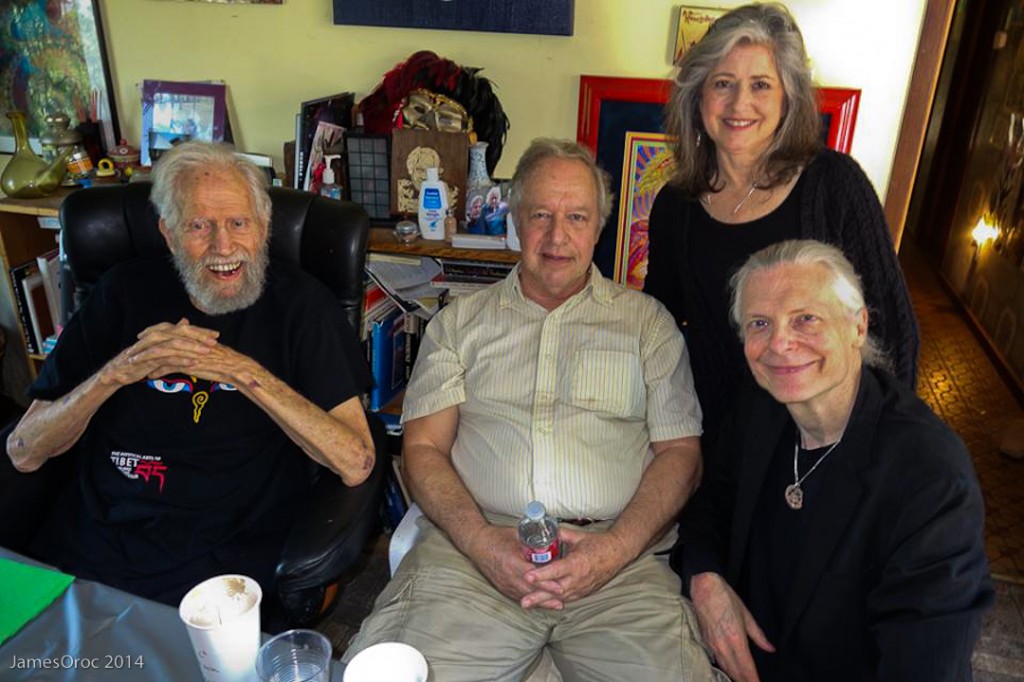
Sasha Shulgin, Nick Sand, Allyson and Alex Grey
I would like to dedicate this series to the memory of Alexander “Sasha” Shulgin who, as arguably the most important Father of this 2nd Psychedelic Revolution, was the subject of Part Two above, and who died before the publication of the series was completed. While I can not claim to have known Sasha well, he was (and will continue to be) one of my greatest inspirations, and I consider the time I spent with him to be one of the great unexpected privileges of my life. It seems fitting to leave the final words on the lasting value of entheogens, taken from the Introduction to PIHKAL, to him, as an inspiration to us all.
“I have stated some of my reasons for holding the view that psychedelic drugs are treasures …. There is, for instance, the effects they have on my perception of colors, which is completely remarkable. Also, there is the deepening of my emotional report with another person, which can become an exquisitely beautiful experience, with eroticism of sublime intensity. I enjoy the enhancement of touch, smell, and taste, and the fascinating changes in my perception of the flow of time.
"I deem myself blessed, in that I have experienced, however briefly, the existence of God. I have felt a sacred oneness with creation and it’s Creator, and – most precious of all – I have touched the core of my own soul."
"It is for these reasons that I have dedicated my life to this area of inquiry. Someday I may understand how these simple catalysts do what they do. In the meantime, I am forever in their debt. And I will forever be their champion.” ~Alexander “Sasha” Shulgin, (1925 – 2014)
http://realitysandwich.com/220236/t...five-a-short-psychedelic-history-of-humanity/